Codes, Policies, & Laws
Code of the West
Agricultural Property Tax
Colorado Noxious Weed Law
Gunnison County Building Code
Water Rights
Colorado Fence and Trespass Law
Right to Farm
Open Burning
Code of the West
Colorado State University Extension and our partners are here to help you improve your rural lifestyle and maintain the values and views that appeal to you about country living. Western Colorado’s diverse landscape creates both challenges and opportunities for a lifestyle that suits your needs. Understanding the limitations created by the amount of precipitation you receive, the elevation, and the soils that occur on your property will help you set realistic goals for managing your lifestyle. Having a plan will help you spend more time enjoying your wonderful surroundings and improve the quality of life for your family.
The unwritten code of the west isn’t so unwritten anymore. It was first documented in 1934 when Zane Grey wrote “The Code of the West.” To this day, the same values of integrity, honesty, stewardship, and self-reliance guide our actions like those rugged individuals who first attempted to settle this land with their families. Consider the fact that the nearest emergency services may be more than 15 miles away, or that the road you’re driving on today might be impassible when severe weather strikes tomorrow. Being prepared for daily life takes on a whole new meaning when you live in a rural area. Recognize that your route to work may be a cow or sheep herding route during certain times of the year where you might literally spend your day counting sheep! These things may be challenges to some folks, but the fact is, this is part of rural living and it’s what likely drew you here in the first place. That and the friendly wave between you and your neighbors as you pass each other on the road each morning. Being neighborly is a two-way street; the fence you help mend today might be good payment for the snow that’s plowed during a fierce blizzard that helps keep your driveway open next winter. Rural residents who come together often have more success as a community than those who go it alone. Working collectively to combat noxious weed infestations will help save money and improve the stewardship of our
resources.
This publication is provided as a brief introduction to considerations for living on your rural property and offers a variety of available resources to help you achieve your property objectives. In the upcoming pages you will be exposed to information compiled from experts throughout our community to help you reach the goals you have set for your rural lifestyle.
Agricultural Property Tax
For property tax purposes, land must meet one of the following five requirements to qualify for agricultural classification:
- A parcel of land that was used the previous two years and is presently being used as a farm or a ranch, or is being restored through conservation practices. Such land must have been classified or eligible for classification as agricultural land during the 10 years preceding the year of assessment.
- A “farm” is parcel of land that is used to produce agricultural products that originate from the land’s productivity, for the primary use of obtaining a monetary profit; i.e., crops that have been raised, harvested, sold or fed.
- A “ranch” is a parcel of land used for grazing livestock for the primary purpose of obtaining a monetary profit. Livestock means domestic animals that are used for food for humans or animal consumption, breeding, draft or profit. Pleasure horses are not considered as livestock. Thus, the keeping of pleasure horses does not qualify a parcel for agricultural classification unless it is a breeding operation that is specifically intended as a profit-making enterprise.
- A parcel of land is considered to be in the process of being restored through conservation practices if the land has been placed in a conservation reserve program established by the Natural Resource Conservation Service pursuant to 7 U.S.C. secs. 1 to 5506, or a conservation plan approved by an appropriate conservation district implemented for the land for up to a period of 10 crop years.
- A parcel of land that has at least 40 acres of forestland and that is subject to a forest management plan. The land must produce tangible wood products that originate from the productivity of the land for the primary purpose of obtaining a monetary profit. Land underlying any residence or other improvements used as an ancillary part of the operation is classified as agricultural land.
 A parcel of land that a) consists of at least 80 acres, or less than 80 acres if the parcel does not contain any residential improvements, b) is subject to a perpetual conservation easement, c) was classified as agricultural at the time the easement was granted, d) the easement was granted to a qualified organization, e) the easement is exclusively for conservation purposes, and f) all current and future uses of the land are described in the easement. This provision does not include any portion of land that is used for nonagricultural, commercial, or non-agricultural residential purposes.
A parcel of land that a) consists of at least 80 acres, or less than 80 acres if the parcel does not contain any residential improvements, b) is subject to a perpetual conservation easement, c) was classified as agricultural at the time the easement was granted, d) the easement was granted to a qualified organization, e) the easement is exclusively for conservation purposes, and f) all current and future uses of the land are described in the easement. This provision does not include any portion of land that is used for nonagricultural, commercial, or non-agricultural residential purposes.
A parcel of land used as a farm or ranch if the owner has a decreed water right or a final permit to appropriated ground water for purposes other than residential use, and water appropriated under such right or permit is used for the production of agricultural or livestock products on the land. This provision does not include the two-year use requirement detailed in item 1.
 A parcel of land that was reclassified from agricultural to another classification and met one of the foregoing requirements during the three years before the year of assessment. The land need not have been classified or eligible for classification as agricultural during the 10 years preceding the year of assessment. Zoning classification of the land parcel has no bearing on how a parcel is classified for tax purposes. Colorado law requires that all parcels be classified for tax purposes according to the primary current surface use.
A parcel of land that was reclassified from agricultural to another classification and met one of the foregoing requirements during the three years before the year of assessment. The land need not have been classified or eligible for classification as agricultural during the 10 years preceding the year of assessment. Zoning classification of the land parcel has no bearing on how a parcel is classified for tax purposes. Colorado law requires that all parcels be classified for tax purposes according to the primary current surface use.
To ensure that land is accurately classified and valued, the assessor may request an on-site inspection and/or additional information such as the IRS 1040-F form filed in the previous year, grazing lease(s), or an agricultural land classification questionnaire. Any documentation provided to the assessor by the property owner is subject to confidentiality requirements as provided by law.
For additional information regarding property taxation procedures in Colorado, contact the Colorado Division of Property Taxation at (303) 866-2371 or contact your local county assessor.
Resources:
Colorado Department of Local Affairs (DOLA); Division of Property Taxation
www.colorado.gov/dola/property-taxation
Useful publications from DOLA online:
– How Agricultural Land is Valued in Colorado
– Classification and Valuation of Agricultural Property in Colorado
Colorado Noxious Weed Law
In Colorado, agricultural and natural resources are protected by the Colorado Noxious Weed Act (35-5.5 CRS, 2003). This law requires landowners to manage undesirable plants, establishes a state-wide noxious weed list, and prioritizes management goals for the weeds on the A (eradication), B (containment), and C (control) lists, respectively.
To manage undesirable plants, the planning and implementation of a coordinated  program that utilizes a variety of management methods will be imposed. These integrated management methods include biological control, chemical control, cultural control, mechanical control, educational opportunities, and preventive measures. The purpose of integrated undesirable plant management is to achieve healthy and productive plant communities by the least environmentally damaging means. The noxious plants that occur in Colorado are any plants that have the potential to aggressively invade or threaten economic crops or native plant communities; are poisonous to livestock; harbor detrimental insects, diseases or parasites; and are detrimental to the environmentally sound management of natural or agricultural ecosystems. Basically, these plants are non-native, aggressive, and will out-compete desirable plants for resources such as moisture, sunlight, nutrients, and space.
program that utilizes a variety of management methods will be imposed. These integrated management methods include biological control, chemical control, cultural control, mechanical control, educational opportunities, and preventive measures. The purpose of integrated undesirable plant management is to achieve healthy and productive plant communities by the least environmentally damaging means. The noxious plants that occur in Colorado are any plants that have the potential to aggressively invade or threaten economic crops or native plant communities; are poisonous to livestock; harbor detrimental insects, diseases or parasites; and are detrimental to the environmentally sound management of natural or agricultural ecosystems. Basically, these plants are non-native, aggressive, and will out-compete desirable plants for resources such as moisture, sunlight, nutrients, and space.
In addition, each county has its own specific noxious weed list and recommended management prescriptions. To obtain a list of the noxious weed species in your area, contact your local noxious weed coordinator, conservation district office, or CSU Extension agent.
Effective weed management and reduction in weed populations can only be met when all persons involved are working together to achieve this common goal. Implementing sustainable land use practices, understanding the resources you have on your property and the weeds that occur, and implementing an integrated approach to noxious weed control will lead to successful weed management on your land. This will help you reach your land management objectives, increase the vegetative diversity of your property, and help to reduce the cost of control over the long term.
Resources:
Colorado Department of Agriculture Noxious Weed Management Program
www.colorado.gov/agconservation/noxiousweeds
CSU Extension – Small Acreage Management – Noxious Weed Resources
www.sam.extension.colostate.edu/topics/weeds
Gunnison County Building Policy
If you’re thinking about building a new garage, shed, or barn on your property in Gunnison County, did you know that your new structure may require a Building Permit? To find out if your new structure requires a Building Permit and what the current Building Codes are, please call the Building Department at (970) 641-1011 and they will be happy to answer any of your questions and help you with the application process.
Some of the most common questions asked are:
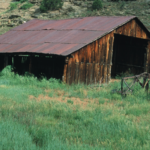 Are garages, sheds or barns exempt from Building Permits? Yes and No, Building Permits are required for all new buildings and additions, except that no Building Permit is required for a one-story, detached storage shed that is no larger than 120 sq ft. An exemption from a building permit can be requested for agricultural structures when part of an agricultural operation and the parcel is classified as agricultural by the Gunnison County Assessor’s Office.
Are garages, sheds or barns exempt from Building Permits? Yes and No, Building Permits are required for all new buildings and additions, except that no Building Permit is required for a one-story, detached storage shed that is no larger than 120 sq ft. An exemption from a building permit can be requested for agricultural structures when part of an agricultural operation and the parcel is classified as agricultural by the Gunnison County Assessor’s Office.
Do structures that are exempt from a building permit require any County approvals? Yes and No, agricultural structures are required to be approved for use, setbacks, floodplain etc before construction, residential accessory structures to be used as tool, storage sheds, playhouses, or similar uses, under 120 sq ft can be placed or constructed without approvals, but must meet all Land Use requirements, including setback and floodplain requirements. If these requirements are not met the owner will be notified and the building may need to be moved. It is always best to receive approvals before placement or construction.
What about the Gunnison Sage Grouse? Gunnison County regulations require that the location of buildings, On-site Wastewater Treatment Systems and accesses be designed to avoid and mitigate potential impacts to Gunnison Sage-grouse. All applications for improvements on lands within Sage-grouse occupied habitat will be reviewed by the Gunnison County Gunnison Wildlife Conservation Coordinator to determine if there are any impacts to Sage-grouse or Sage Grouse habitat. Landowners may request a pre-application conference to review Sage-grouse issues and identify potential solutions.
What is the Gunnison County Land Use Resolution? The Resolution governs most land development, and includes standards for setbacks, building heights, sizes of residences, design, location on ridgelines, building in geologic hazard areas, floodplains and wetlands, and other requirements that will affect where your building site can be located.
What other permits might be required?
•Gunnison County On-site Wastewater Treatment Systems, available in the Community Development Department.
•Gunnison County Driveway Access Permit or Waiver, available from the Gunnison County Public Works Department.
•Highway Access Permit from the Colorado Department of Transportation, if a parcel is located on a state or federal highway.
•Gunnison County Reclamation Permit, available from the Gunnison County Public Works Department.
•Well Permit, available from the Colorado Division of Water Resources in Montrose.
•Electrical Permit, available from the Colorado Electrical Board. A state Electrical Inspector is located in Gunnison.
•Plumbing Permit, available from the Colorado Examining Board of Plumbers. A state Plumbing Inspector is located in Gunnison.
A Land Use Change Permit may be required before a Building Permit can be issued, or conditions of an existing Land Use Change Permit may affect building locations or sizes, and other features.
What is the benefit of a Building Permit and Certificate of Occupancy?
When a building permit is issued and inspections are completed and passed, a Certificate of Occupancy or completion for the use is issued and a copy is saved in the permanent file, which can be viewed by Insurance Companies, Mortgage Companies, Real Estate Companies or the public in researching the legal use of the structure.
What does a Building Permit cost?
Building permit fees are calculated from a valuation of the building or structure and are changed occasionally, please call the building department and provide an approximate cost of construction, the type and size of the structure and they can provide you with an estimated Building Permit Fee.
How long does it take to be approved or to be issued a permit?
It depends on the work load at the time of submittal but usually within 10 working days.
What would be the best way to make sure that all Gunnison County requirements are met before work begins?
Make an appointment with the Building Official and GC Planner to discuss your project.
Water Rights
Under the Colorado Constitution, the water of every natural stream within the state is the property of the public, and is dedicated to the use of the people. All persons have a right to appropriate the waters of the state and put them to beneficial use, subject only to the rights of those who have previously appropriated such water.
A water right is created when a person initiates an appropriation of unappropriated water of a natural stream of the state. An “appropriation” is simply the “beneficial application or use of a specified portion of the waters of the state pursuant to the procedures prescribed by law.” The water right so created and acquired is usufructuary in nature—the owner of the right does not own the water, rather only the right to use it.
The priority of a water right is a function of the date of adjudication and the date of appropriation. Subject to certain narrow exceptions, a water right with a given adjudication date will be senior to all water rights with a later adjudication date, and junior to all water rights with an earlier adjudication date—hence the expression, first in time, first in right. During periods of high flow, there is generally sufficient water available for all users. As stream flows drop at the end  of the run-off season, junior water rights are curtailed to provide water for the senior rights. There may be times when there is not sufficient water available even for senior water rights.
of the run-off season, junior water rights are curtailed to provide water for the senior rights. There may be times when there is not sufficient water available even for senior water rights.
A water right adjudication is a proceeding to confirm the existence water rights and to determine the respective priorities of water rights on the stream system for purposes of administration. A water right decree confirms the existence of the water right but does not create or confer the right. The reason for adjudicating a water right is to realize the protection of enforcement of the priority system of water rights through administration by the State and Division Engineer. Without a decree, the owner of a water right cannot make an enforceable “call” to the State and Division Engineer to curtail undecreed water uses and decreed junior rights that might otherwise intercept water necessary to satisfy such owner’s water right.
Source:
Law of the Rockies, Attorneys at Law, Gunnison, Colorado.
www.lawoftherockies.com
Water Ditches and Easements
When a water right owned by one person originates on or passes through land owned by another, the relative rights and responsibilities of the parties can become an issue. When purchasing land with existing ditch easements, the owner of the easement has the right and duty to use and maintain their ditch across your property. Adequate head gates on diversion structures and measuring devices are required to allow flows from the stream system to be controlled efficiently. Easement owners are required to keep their ditches in good repair to prevent flooding or damaging the property of others. If you do not own shares in the ditch on your property, you do not have the right to use, withdraw or impede the flow of water in the ditch.
Ponds and Reservoirs
There are two basic types:
- Non-jurisdictional ponds/reservoirs include: when a dam measures less than ten feet deep; impounds less than 100 acre feet; or a surface area at high water line of less than 20 acres. If you are building a non-jurisdictional dam, you must file a Notice of Intent to Construct.
- Jurisdictional ponds or reservoirs, which exceed any of the limits set for non-jurisdictional dams, above. These require plans and specifications prepared by an Engineer, and need approval by the State Engineer. The primary responsibility for maintaining a safe dam rests with the owner. State statute places liability for damages on the owner if the dam fails.
Livestock ponds and erosion control dams are limited to drainages that are dry 80% of the time, They are not decreed by the Water Court. The Natural Resource Conversation Service (NRCS) can provide cost–share assistance in the design and construction of these dams.
Water Wells
A permit is required prior to the construction of a well, or for the replacement of a well pump. Application forms and assistance can be obtained from the Division Engineer’s Office. An underground water right is required for all wells that produce more than 15 gallons per minute; or which are for the irrigation of more than one acre. Wells used for ordinary household use, watering domestic livestock, and irrigation of less than one acre of land also require a permit, but are exempt by statute from administration or the necessity of obtaining a water right.
Resources:
Irrigation Ditches and their Operation. CSU Extension Factsheet 6.701
Private Wells for Home Use. CSU Extension Factsheet 6.700
Colorado Fence and Trespass Law
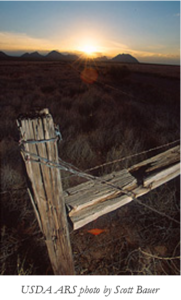 Either living in an urban area or on the rural landscapes of Colorado the old adage “Good fences makes good neighbors” rings true still today. In the early years of statehood, Colorado enacted the “Fence Law” or “Open Range Law” and this legislation is still in force today with some revision. The Fence Law in Colorado addresses key items like defining what a lawful fence is, who is responsible for construction and maintenance of lawful fence and who can claim damages for trespass. This article is a summation of the Colorado Statutes that pertain to the “Fence Law”.
Either living in an urban area or on the rural landscapes of Colorado the old adage “Good fences makes good neighbors” rings true still today. In the early years of statehood, Colorado enacted the “Fence Law” or “Open Range Law” and this legislation is still in force today with some revision. The Fence Law in Colorado addresses key items like defining what a lawful fence is, who is responsible for construction and maintenance of lawful fence and who can claim damages for trespass. This article is a summation of the Colorado Statutes that pertain to the “Fence Law”.
The Colorado Statutes #35-46-101 clearly defines two important terms for addressing issues that apply to fencing and trespass “Lawful Fence” and “Livestock”. The following are the definition of the terms from the Colorado Revised Statutes and they should be referred to when building, maintaining, repairing and replacing any fences.
“Lawful fence” is a well-constructed three barbed wire fence with substantial posts set at a distance of approximately twenty feet apart, and sufficient to turn ordinary horses and cattle, with all gates equally as good as the fence, or any other fence of like efficiency. “Livestock” includes horses, cattle, mules, asses, goats, sheep, swine, and buffalo. In working toward resolution in disputes of livestock grazing the first determination is if a “Lawful Fence” was in place and properly maintained.
Construction and Maintenance of “Lawful Fence”
In Colorado it is the responsibility of the landowner to fence out any livestock from their property with a “Lawful Fence”. Colorado Statute #35-46-112 puts the burden of the cost of constructing or repairing a fence on adjoining properties on both land owners. Caution should be taken in that the statute only requires a land owner to meet the standard of the definition of a lawful fence. If one land owner wants to make the fence to a higher standard that landowner may be responsible for the additional costs. In any case they should follow the procedure set forth in Statute #35-46-113 – If after thirty days written notice (certified letter), served personally or by registered mail by either owner or tenant of another, if such owner neglects or refuses to erect or repair one-half of the partition fence, the person giving notice then may undertake repairs and may collect by a civil action one-half of the cost. Refers only to a “Lawful fence”. It is always good practice to have written documentation of all agreements and how you complied with the above procedure before purchasing any materials.
Livestock Trespass
Colorado Fence Laws benefit the livestock owner by putting the responsibility on landowners and crop producers to fence out. Livestock owners are not liable for animals that wonder on to property that a “Lawful Fence” is not maintained. Colorado Statute #35-46-102 does give provision that helps protect landowners from stock produces that knowingly drive herds on to another person’s land or from repeated livestock trespass where a “Lawful Fence” is in place and maintained to recover damages through a civil court process. In any case of livestock trespass it is best that you keep local sheriff’s office and brand inspection office involved.
There are some generalizations that can be made in helping with issues that arise between neighbors in regards to livestock and fencing:
- Always refer to updated Colorado Revised Statutes on Fencing Laws and consult with local law enforcement and brand inspection.
- Make sure that a “Lawful Fence” is in place and that it is regularly maintained.
- Colorado fence laws favor the livestock owner and put the duty of protecting property on the landowner.
- An open and good working relationship with adjacent landowners is the best prevention for issues with livestock and fencing.
This article was prepared to help address perception and concerns that landowners have with Colorado Fencing Law. Information was taken from Colorado Revised Statutes and the Colorado Department of Agriculture. It is recommended that landowners should obtain a full updated copy of the statutes before taking any action in regards to fencing laws or contact your local CSU Extension Agent for additional information.
Resources:
Colorado Revised Statute on Fencing Laws. CO Dept. of Agriculture Open Range and Fencing
Fencing with Wildlife in Mind. Colorado Division of Wildlife
Right to Farm
Right to Farm
Colorado is a “Right-to-Farm” state. Landowners, residents, and visitors must be prepared to accept the activities, sights, sounds, and smells agricultural operations as a normal and necessary aspect of living in a county with a strong rural character and a healthy agricultural sector. Those with an urban sensitivity may perceive such activities, sights, sounds, and smells only as inconvenience, eyesore, noise, and odor. However, state law and individual county policies provide that ranching, farming, or other agriculture activities and operations shall not be considered to be nuisances so long as operated in conformance with the law and in a non-negligent manner. Therefore, all must be prepared to encounter noises, odors, lights, mud, dust, smoke, chemicals, machinery on public roads, livestock on public roads, storage and disposal of manure, and the application of spraying or otherwise of chemical fertilizers, soil amendments, herbicides, and pesticides, any one or more of which may naturally occur as part of legal and non-negligent agriculture operations.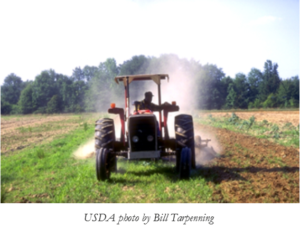
In addition, all owners of land, whether ranch or residence, have obligations under state law and county regulation with regard to the maintenance of fences and irrigation ditches, controlling weeds, keeping livestock and pets under control, using property in accordance with zoning, and other aspects of using and maintaining property wisely. Residents and landowners are encouraged to learn about these rights and responsibilities and act as good neighbors and citizens.
Resources:
State of Colorado Right to Farm Statutes
Open Burning
Generally, anytime you light a fire outdoors, you are conducting an open burn. The State of Colorado regulates open burning to help protect public health and the environment. An Open Burning Permit must be obtained for opened burning. Permits are issued by the state as the permitting authority. Anyone performing an open burn in Colorado needs to obtain a permit.
Please be aware that many cities and counties have adopted local rules and ordinances related to open burning. Any person seeking a state permit for an open burn should also check with any appropriate fire control office, local agency, or other officials regarding specific local requirements for open burns, prior to applying for a state open burning permit. In some instances, applications for permits can be obtained from your local County Health Department.
Materials that may be burned include untreated, natural wood sticks and branches, leaves, dry grass, slash and weeds. All burns must be performed in open piles. Materials that are not allowed to be burned include tree stumps, tires, chemicals, plastic, cut lumber, construction debris, and trash. The burning of household trash is prohibited. Please check with your local authorities before conducting any type of burning on your property. The use of a backyard burn barrel or burn pit is not allowed, anyone open burning household trash will be subject to fines.
Permit Exemptions
- Flares used to indicate some danger to the public.
- Campfires for instructional or recreational purposes and non-commercial cooking fires.
- Agricultural burning is exempt from open burn permitting. These burns are still subject to fire district and municipal fire rules. Agricultural burning is defined as the burning of water conveyance ditches and/or fields to prepare the soil for crop production; for weed control and other agricultural cultivation purposes. Please note that land zoned as “agricultural” does not automatically provide exemption from open burning permitting.
In granting or denying such permits, the department bases its decision on the location or proximity of a proposed burning to any building or structure; the potential contribution of the proposed burning to air pollution in the area; climatic conditions on the day or days of burning; and compliance by the applicant for the permit with applicable fire protection and safety requirements of the local authority. Other considerations in the permitting decision include whether any practical alternative method for the disposal of the material to be burned exists, and whether the burning will be conducted in a manner that will minimize emissions.
Land Management
Managing Small Pastures
Weed Management
Water Quality
Water Disposal Systems
Soils
Hay Production
Alternative Agricultural Enterprises
Living with Wildlife
Is Your Firewood Infested
Managing Small Pastures
Small pastures are particularly susceptible to overgrazing. Overgrazing often occurs when there are too many grazing animals on the pasture for too long. It can also occur when animals are allowed to re-graze the pasture before they are ready for grazing. Many people overlook the importance of managing these pastures, but with a little planning you can save money by maximizing the amount of healthy forage you produce on your land.
Matching the vegetation of your pasture to your land management objectives and your site will ensure successful grazing. Grazing practices can alter the composition of a pasture. Practicing basic range or pasture management principles is important. A general rule of thumb for small pastures is to adhere to the “take half and leave half” principle. The idea is that by only grazing one-half of the available and desirable forage and leaving one-half for re-growth, the existing plant community is sustainable. By not grazing too much of a plant, the plant is allowed to re-grow and replenish its energy root reserve. A second management principle is grazing time. Grazing too early in the spring does not allow the plant to replenish its energy reserves, and consequently, it cannot re-grow as fast as other un-grazed grasses. Impacts on a plant from grazing vary throughout the year and growing season. Plants are most severely affected from grazing during seed formation when they need maximum energy to produce seeds. Grasses grazed while dormant are not as adversely affected because the plant has already stored its energy for the following spring.
There is no standard reference on the amount of available forages for different pastures in the intermountain west. In order to know exactly how much production is occurring on your plot, clip a small area that is representative of the pasture and weigh it after allowing it to air dry. Typically, grazing animals need 2-3% of their body weight of air-dried forage daily.
Tips for Improving Small Pastures and Encouraging More Grasses
- Do not impact grasses, reduce the severity of grazing or allow for longer rest periods.
- Keep animals off pasture in the spring until there is eight inches of grass growth.
- Use a rotating grazing scheme. Rotation grazing refines the “take half and leave half” principle and lets you manage your pasture more intensively, increasing forage production.
- Control your weeds. Many pastures that have historically been abused or allowed long-term rest will have more broadleaf plants and brush species than grasses. Applying a broadleaf herbicide suppresses the broadleaves and aids the grasses re-establishment of dominance.
- In worst case scenarios where a pasture is severely overgrazed or weedy, renovation or reseeding may be needed. Reseed with a mixture of grass plants.
Resources:
Colorado Forage Guide
Livestock Management
Weed Management
Weed Management = Good Land Stewardship
While weeds have long been a bane of agriculture, they have generally not been a problem for urban or suburban landowners except in vegetable and flower gardens. However, this situation is changing as ranches are converted to large-lot subdivisions, especially where horses or livestock are grazed on small tracts of land. Weeds affect local wildlife, invade open space and poison horses. New rural landowners are discovering that managing weeds is one of the responsibilities of land ownership. Unfortunately, many of these landowners don’t have detailed knowledge about weeds. One of the reasons for preparing and implementing a weed management plan for your property is to be a good neighbor. Being a good neighbor requires landowners and managers to be alert for new weed infestations and to control existing infestations. Weed management is also much more successful if neighbors join together to control weeds that readily spread from place to place. Although private landowners and public land managers may have different perspectives on weeds, they share the common goal of protecting their property.
Why Should We Be Concerned About Weeds?
The effects of weed infestations are widespread and affect many aspects of our lives.
Ecosystem Processes
- Weeds can drastically alter the ecological checks and balances that have developed over thousands of years.
- The growth and spread of weeds can alter fire patterns and intensity, resulting in major ecosystem changes.
- Some nitrogen-fixing plant species increase soil nitrogen levels to the point that other non-native plant species outcompete native species that have evolved in nutrient-poor soils (Vitousek 1986).
- Weeds can affect soil erosion and aquatic habitat in nearby streams and ponds. A spotted knapweed study showed that runoff increased by 56% on areas infested by spotted knapweed and that sediment yield increased by 192% (Lacey et al. 1989).
Wildlife
- Many alien plant species provide poorer habitat for wildlife species and livestock than their displaced native counterparts. Studies in Montana showed a 98% decrease in elk use of a bunchgrass range and a 67% decline in carrying capacity after spotted knapweed took over (Hakim 1979).
- Tamarisk and Russian olive thickets along rivers provide much poorer wildlife habitat than native cottonwood and willow communities (Carpenter 1997, Knopf and Olson 1984).
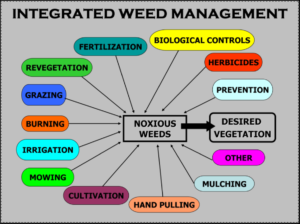
Agriculture
- Weeds create large economic losses for agriculture in both cropland and rangeland situations.
- Weeds can reduce the production of forage for livestock by crowding out palatable species.
- Some species like St. Johnswort, Russian knapweed and leafy spurge are toxic to livestock.
- Ranches that have been infested by leafy spurge sometimes now sell at a fraction of their values prior to leafy spurge infestation (Olson 1999).
Weed Management Strategies
Landowners should use an management strategy in dealing with weeds beginning with:
- Recognize weed management to be an on-going process where the outcome of control efforts may vary.
- Establish your management goals for your property. Pasture for horses, Hay production, wildlife, etc.
- Identify weed species. Take suspect weeds to your Weed Management professional or CSU Extension office for identification. They in turn will assist in developing a management plan based on your personal goals and objectives.
- Monitor the results of management actions and evaluate the results in light of the management goals for the property.
Consider This Before Spraying
When spring arrives and many ranchers’ and home owners’ thoughts turn to controlling weeds. Before you hook up the trusty (or in some cases, rusty) sprayer and give ‘er a go, think about the following things:
Identify the weeds
Weed identification is essential to know which control options apply. Pulling or mowing might be your best option (The CSU Extension office or the Gunnison County Weed Department can help).
Should I spray?
Before you hook up the sprayer, scout your pastures and decide whether you have enough weeds to justify spraying. You should not try to achieve 100-percent control of all weeds, which is seldom cost-effective. However, the presence of serious noxious weeds requires your immediate attention. Examples include: Leafy spurge, White top, Knapweeds and yellow star thistle.
Calibrate the sprayer
If your sprayer is not properly calibrated, you have no idea how much herbicide you’re applying. Applying too much herbicide wastes money and applying too little gives poor control of weeds.
Spray the right product
Always read the label for the list of weeds controlled by a product before you spend money on it.
Spray at the right time
Be sure to scout to make sure the weeds are up before you spray in early spring unless you’re using a product with residual control. (Read the product label).
Most weeds are easiest to kill when they are small. Almost all weeds are easier to kill when they’re young and actively growing than if they’re mature or drought stressed. One exception to this rule is Canada thistle which is best controlled in the fall.
Control drift
Make sure your herbicides get on your weeds on your property and nowhere else. Check the wind before you spray, and don’t apply herbicides when the wind is too strong or is blowing in the direction of your neighbor’s plants. Calibrate your sprayer for coarse droplets instead of fine sprays coming out of your nozzles. This can also reduce drift.
Follow the label
The label is the representation of a federal law. If you do something out of compliance with the label, it is a violation of federal law. On a softer note, the things written into the label are there to help you get the most out of a product. Pay attention to the safety information, it can save your health. Look at the list of weeds controlled; it can keep you from using the wrong product. Check to see if a surfactant or additive is needed — it can make the material work much better.
Water Quality
Water Quality Standards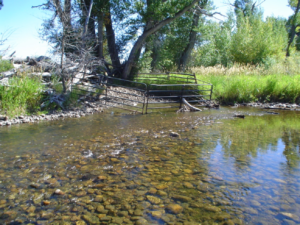
Today, the EPA is working harder to quantify and reduce sources of non-point pollution. This is primarily accomplished by encouraging or requiring people to engage in pre-determined best management practice (BMP). A variety of water BMPs are available through your local Colorado State University (CSU) Extension Office.
Drinking Water Quality
For many people in Western Colorado, residential drinking water is supplied by a municipal water treatment plant. More information on this type of water treatment can be obtained from the EPA’s Safe Drinking Water Hotline, (800) 426-4791. However, there is no regulation for the quality of water from a private water system. In addition, if your drinking water comes from a private well, you are responsible for monitoring the safety of your own drinking water. Protecting your drinking water supply from contamination is important for health, to protect property values, and to minimize potential liability.
The natural quality of well water varies from location to location because of the influence of local geology and soils through which the water is filtered and stored. Groundwater contamination can result from point sources, such as leaking underground fuel storage tanks, animal feedlots and septic systems. Landfills, abandoned mines and industrial discharges can also impact rural groundwater quality. Older, shallower wells are generally more easily contaminated than deeper wells dug with properly-installed casing and well cap.
The appearance, taste or odor of water from a well or other source offers some information on obvious contamination, but chemical analysis is needed to detect most contamination in water. Obvious contaminants include silt and hydrogen sulfide, which can be detected by smell, but other contaminants such as bacteria and nitrate are colorless and do not have an odor. Two types of tests, bacteriological and chemical, can be used to assess water quality.
Resources:
Domestic Water Quality Criteria, CSU Extension Fact Sheet No. 0.513
Drinking Water Quality
Bacteriological tests are used to determine whether water contains bacteria that are harmful for human health. A passing test will indicate the absence of these bacteria. Anyone wanting a bacteriological test performed on drinking water should contact the local County Health Department to obtain the specially-prepared bottles and instructions for taking a water sample. Chemical tests are used to identify impurities and other dissolved substances that can affect water used for domestic purposes. Common analyses include metals, nitrate, acidity or alkalinity (pH) and relative hardness of water, for example. The CSU Soil, Water and Plant Testing Laboratory can perform these analyses for you. Your local Extension Office has the contact information, price lists and sampling instructions, as well as information on other private laboratories that can provide similar services.
Questions to Ask About Water When Buying Property
- Is the household water source a public water supply or well? If well, how is it permitted and when is the latest water test available?
- Is the septic system recently installed and/or maintained (pumped)?
- Are there water rights associated with the property? If so, what is their priority and how often can I expect water and how much?
- What is the ditch system or company associated with the water rights and what are the annual fees or assessments for the water?
- What kind of irrigation infrastructure exists and what is their condition?
- If the irrigation is flood or furrow, where does runoff from the irrigation events leave the property? What are my responsibilities associated with this runoff?
Resources:
Drinking Water Quality and Health, CSU Extension Fact Sheet No. 9.307
Selecting an Analytical Laboratory, CSU Extension Fact Sheet No. 0.520
Bacteria in Water Wells, CSU Extension Fact Sheet No. 6.703
Protecting Your Private Well, CSU Extension Bulletin XCM-179
Agricultural Water Quality
Water Quality for Livestock
Although most livestock can tolerate water quality that may be unsuitable for human consumption, very poor water quality can impact livestock health, reproduction and performance. If the water quality of your livestock’s drinking water is unknown, it should be tested for salinity, pH, sulfate, nitrate and potential toxic elements such as selenium. Elevated metals or salts, for example, can cause a variety of health and reproduction problems, and pregnant or lactating animals may be more susceptible. If a water test report shows that the water contains toxins at levels too high for livestock, treatment or an alternate source of water may be necessary.
Irrigation Water Quality
Irrigation water with high salinity levels may be a problem in areas of Western Colorado. Using excessively saline irrigation water can stunt plant growth and increase the total salt content of the soil. Plants watered with highly saline water tend to wilt, even though they appear to be receiving plenty of moisture. Too much salt in irrigation water prevents sufficient water from being absorbed by the roots. To alleviate the level of salt in your irrigation water, it is important to understand the salinity, electrical conductivity (EC), and total dissolved solids. Your water can also be tested to determine whether it contains concentrations of other potentially harmful constituents. Under some conditions, irrigation water with a high pH (8 or higher) may also limit the nutrient availability of the soil. Other elements of potential concern are chloride and boron. Your local Extension Office can help you conduct an analysis of your water.
It is additionally as important to understand proper irrigation management principles. Consider consulting with a CSU Extension Irrigation Specialist to determine the appropriate irrigation management practices for your individual field conditions.
Resources:
Glossary of Water Terminology. CSU Extension Factsheet 4.717
Irrigation Water Quality Criteria. CSU Extension Fact Sheet No. 0.506
Managing Saline Soils. CSU Extension Fact Sheet No. 0.503
Managing Sodic Soils. CSU Extension Fact Sheet No. 0.504
Diagnosing Saline and Sodic Soil Problems. CSU Extension Fact Sheet No. 0.521
Water Disposal Systems
Living With Your On-Site Sewage Disposal System
Managing your septic system is a very important aspect of living “in the country”. Ensuring the system is cared for and properly maintained is your responsibility. A septic system is an individual wastewater treatment system using soil to treat small wastewater flows from a residence. A conventional system consists of a septic tank and a drain or “leach” field. This is a simple system, but must be adequately maintained. Neglecting a septic tank is the most common cause of damage to the leach field. When the tank is not pumped routinely, sludge builds up to the point where they are carried into the leach field and block the flow of liquid into the soil. When this occurs, the leach field must be replaced, which is an expensive project. Many homeowners inquire about the best type of septic additive for their system. The answer to this is very simple: There isn’t one! Proper use will ensure a healthy and stable bacterial population. Bacteria are vital to the breakdown of the solids. The best way to prevent septic failure is to observe a routine pumping schedule.
About the Septic System
The first stage in securing a proper system is via the septic tank. All the water used in your home is diverted to this underground tank. It is a watertight container, usually made of concrete, that temporarily holds materials while heavy 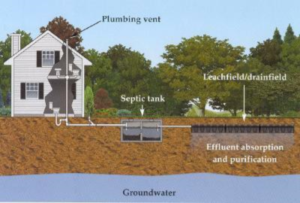 solids settle out. These solids are primarily decomposed by bacteria, however, the solids do accumulate requiring removal to ensure proper functioning of the system for the long term.
solids settle out. These solids are primarily decomposed by bacteria, however, the solids do accumulate requiring removal to ensure proper functioning of the system for the long term.
The drain field (or leach field) allows effluent (the liquid left after the solids have settled out) to flow from the septic tank through underground pipes to seep into the gravel and then into the soil. This is the second stage in the wastewater treatment process. Nutrients, organic materials and pollutants in the effluent are degraded by soil microbes. These materials are removed from the water before reaching groundwater.
Engineered Systems
A conventional system is not always the best approach. Some sites require special engineering because of inappropriate soils (high clay or sand content), shallow bedrock or a high groundwater table. Engineered systems require professional design and installation. Your installer will have tips for the operation and maintenance of these special systems.
Maintenance
Inspect your tank annually for sludge level and structural integrity and pump your tank according to the recommended intervals. The costs for regular inspection and pumping are far less than repairing and/or replacing your system.
Table – Recommended Pumping Tank Intervals  Source: www.thenaturalhome.com
Source: www.thenaturalhome.com
Septic Do:
- Know where your system is located: keep a diagram showing the location of your system
- Inspect your system every year
- Pump your tank regularly
- Keep records of pumping, inspection, and other maintenance
- Repair leaking faucets and toilets
- Install washing machine lint and effluent filters
- Conserve water to reduce wastewater
- Divert roof drains and surface water away from drain field
- Limit the use of drain solvents, household chemicals, strong disinfectants and chlorine
- Call a professional when you have questions
Septic Don’t:
- Park, drive vehicles over, or allow large animals on any part of your septic system
- Place sprinkler systems close to the leach field
- Dig or build on top of your septic system
- Plant deep-rooted plants over the drain field
- Dispose of sanitary napkins, diapers, cooking oil, solvents, paint, etc. Use garbage disposals sparingly, do not put coffee grounds, fats, or meats into a septic system
- Breathe emitted tank gasses – these are toxic
- Ignore odors, wet or sunken spots, or lush growth above the drain field
Resources:
Homeowners Guide to Protecting Water Quality and the Environment. XCM-223
Soils
Soils and soil parameters, such as nutrient levels, can vary within a field and from field to field. These variables can affect a wide range of management decisions. Western Colorado soils can include heavy clay to well-drained sandy soils encompassing many characteristics including being shallow or deep, deficient or adequate in organic matter content, or high in salts–to name a few.
Soils in river valleys and surrounding areas of Western Colorado were formed by sandstone from the Uncompahgre uplift, volcanic rock, and deposits left by the Mancos Sea, a prehistoric inland sea. The Mancos Sea advanced and retreated 29 times, laying down layers of salty soil each time, which compressed into Mancos Shale. When the sea finally withdrew from the area, deposits were as deep as two miles thick. Volcanic flows later capped parts of these salty deposits.
sandstone from the Uncompahgre uplift, volcanic rock, and deposits left by the Mancos Sea, a prehistoric inland sea. The Mancos Sea advanced and retreated 29 times, laying down layers of salty soil each time, which compressed into Mancos Shale. When the sea finally withdrew from the area, deposits were as deep as two miles thick. Volcanic flows later capped parts of these salty deposits.
Mancos Shale decomposes into very productive soil with a high capacity to hold water and plant nutrients. By managing the area’s long growing season (up to 188 days) and utilizing highly-developed irrigation systems, the river valley can be excellent for crop production.
A soil testing program helps to manage the land and helps to answer the following questions:
1. Are soil nutrients deficient or excessive?
2. Which crop fertilizer program is best?
3. Does the soil have a salinity problem, and what effect will the salt have on the crop?
4. What is the pH and organic matter level, and can it be adjusted?
Annual field sampling and testing is recommended for accurate crop and nutrient management. Obtaining a representative soil sample from the planting area is critical for accurate results. To begin, divide the area into sites that are similar in soil type, slope, or other characteristics. For collection, use clean equipment, free of soil particles and rust. Collect 15-20 samples from the top eight to 12 inches of soil in a random or systematic pattern. You can do this in up to 40 acres of land. Mix the samples from a single sample area in a plastic bucket. Collect about two cups of the mixed sample to submit to the laboratory for analysis. Nitrogen recommendations for irrigated crops, should include subsoil samples (12 to 24 inches) as well as surface samples to account for the available nitrogen throughout the root zone.
Understanding Soil Sampling
The samples can be air dried prior to sending them or they can be sent in a moist condition. Do not oven dry samples or expose them to extremely hot conditions. Keep samples in the shade or in a cooler with ice to prevent heat buildup if conditions are hot and dry. Western Colorado soils tend to be calcareous, which means that they contain residual or free lime (lime as small particles in the soil). The testing process should use lab procedures designed for these high lime type soils.
In Colorado, the analysis of soil samples should use ammonium bicarbonate-DPTA (AB-DTPA) to extract soil for analysis. AB-DTPA is a multi-use extractant for nitrate, phosphorus, potassium, and micronutrients and is used primarily by the Soil, Water, and Plant Testing Laboratory at Colorado State University. Other processes can be used to determine the nutrient levels in soils, however these are appropriate for more acidic pH levels. The AB-DPTA analysis provides the best results for high pH (alkaline) soils.
Western Colorado’s river valley soils typically have a pH of 7.5 to 8.5, a basic alkaline condition. Although soil pH can sometimes be reduced by using acidifying agents, such as elemental sulfur or sulfuric acid, Western Colorado soils are highly buffered with free lime (calcium carbonate). If sulfur is added to the soil, it combines with water and oxygen through bacterial activity, producing sulfuric acid. The sulfuric acid will neutralize calcium carbonate to produce water, carbon dioxide and calcium sulfate and, instead of changing the pH when this reaction occurs, salt levels may increase, due to the increase in concentration of the salt gypsum (calcium sulfate). “Alkaline” is not the same as “alkali.” “Alkali” refers to sodium salts, while “alkaline” refers to pH. Very few areas in Western Colorado have problems with sodium salt; our salts area typically calcium-based.
For more information on soil testing and specific recommendations for the area, contact your local Extension Office or the CSU Soil, Water, and Plant Testing Lab at 970-491-5061.
Resources:
Soil Testing. CSU Ext. Fact Sheet 0.501
Soil Test Explanation. CSU Ext. Fact Sheet 0.502
Soil Sampling. CSU Ext. Fact Sheet 0.500
Hay Production Considerations
Hay is one of the most common crops raised in western Colorado. Small acreages are highly conducive to raising hay on either dry or irrigated land. Alfalfa and grass (meadow) hay are the two basic types of hay grown.
Alfalfa
Alfalfa can be grown on a wide range of soil and climatic conditions. Alfalfa is a deep-rooted perennial and is best adapted to deep, well-drained loam soils. Poor drainage promotes root and crown disease, inhibits nitrogen fixation and reduces winter survival. Alfalfa is relatively drought-tolerant; however, forage production will be in proportion to the amount of available water. Alfalfa is grown as an irrigated crop in many places on the West Slope, but also planted as a dryland crop in areas that receive adequate moisture. Alfalfa stands can last 10 years or longer. Seed beds need to be firm, which can be accomplished by using a cultipacker or packer wheels on the drill when seeding. Poor seed bed preparation is the most common reason for establishment failure.
A soil test for nitrogen and phosphorus should be done prior to seeding to ensure adequate fertilizer is applied if needed. Fertilizer is commonly applied to alfalfa during establishment. It takes at least one growing season for a stand to become established. To maximize forage quality and ensure adequate root reserves for re-growth, cut alfalfa when the crop is in the late-bud to 1/10-bloom stage. This will provide adequate time for plant recovery during each cycle of re-growth, creating a healthier and longer-lived stand.
Native Grass Hay
Native grass hay, whether irrigated or dryland, does not usually require seeding to ensure an adequate crop. Grass hays in intermountain valleys are made up of a combination of brome, timothy, orchard grass, bluegrass, red top, ryegrass, wheat grass, and clover. Grass hays typically have only one crop per year, depending on location and water available. Dryland grass hay yields from 0.5 to 1.5 tons per acre. Irrigated hay produces 2-4 tons per acre.
Grass hay is commonly harvested from June through August. Harvesting later in the year increases yields slightly. However, nutritional content decreases the later the hay is harvested. For optimal production, grass hay should be harvested when the grass is flowering. It is usually not feasible for small farms to own all of their own hay equipment; thus, sharing equipment with a neighbor or having it custom harvested is very common. Custom haying is done on a cash or share basis. A cost estimate for cash basis is listed above and share arrangements are customarily 2/3 to 1/3 with the landowner receiving 1/3.
Planting Grass Hay
At times it may make sense to plant grass hay, such as when converting a field from small grain production, in an excessively weedy field, or in severely overgrazed areas. Species choice depends on your objective and the condition of the area to be planted. There are several choices of species, depending on whether the site is well-drained, poorly-drained, a wetland, sub-irrigated, or contains high salt conditions. A list of species and seeding rates appropriate for your situation can be obtained from your local Extension Office.
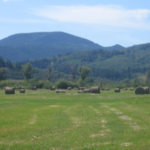 Marketing Hay
Marketing Hay
There is often strong demand for hay locally, meaning you don’t have to market the hay outside the area. An advertisement in the paper or just word of mouth is all that is usually necessary to establish buyers.
There are some specialty markets for different classes of hay that usually demand a slight premium, and “horse hay” is such a market. Horse hay (in the buyer’s eyes) needs to be bright green, have a high percentage of timothy grass, have absolutely no mold, and shouldn’t have been rained on between cutting and baling. Packaging the hay in small square bales (70 lbs.) versus large round or square bales (500-1500 lbs.) caters more directly to the horse market. Large bales are usually discounted as they are harder for small livestock and horse operators to handle.
An additional market for hay has been established that is “certified weed free.” Weed free entails an inspection of the field prior to mowing to ensure there are no noxious weeds and then marketing the bales as “weed free.” Many federal land agencies in Colorado now require only weed-free hay on all lands in the state. Other unique markets include “organically grown” hay and “dairy quality” alfalfa. Contact your Extension Office for information on how to get your crop certified weed-free or organic.
Hay prices vary throughout the year, but tend to be lowest in late summer and highest in mid and late winter. As with all agricultural commodities, prices for hay fluctuate due to supply and demand, which can be affected by drought, late or early frost, etc.
Resources:
Fertilizing Mountain Meadows. CSU Ext. Fact Sheet 0.535
Intermountain Grass and Legume Forage Production Manual
Alternative Agricultural Enterprises
Establishing a goal of developing an alternative, or specialty agricultural  enterprise is usually the result of a desire to pursue a personal interest while also generating an economic return from your land. These types of agricultural enterprises can take a variety of forms, some examples include: new and different crops or livestock enterprises, value added products, agritourism or recreation, natural and organic production systems, or biodynamic food, as well as direct marketing strategies through farmers markets, roadside stands, community supported agriculture, and even online delivery.
enterprise is usually the result of a desire to pursue a personal interest while also generating an economic return from your land. These types of agricultural enterprises can take a variety of forms, some examples include: new and different crops or livestock enterprises, value added products, agritourism or recreation, natural and organic production systems, or biodynamic food, as well as direct marketing strategies through farmers markets, roadside stands, community supported agriculture, and even online delivery.
An approach to determining the potential success of a particular agricultural enterprise involves consideration of key factors including production, marketing, and management. A wise agricultural entrepreneur would need to have a thorough business plan, including an inventory of natural and personal resources, and clear answers to the following:
- Do I have the personal characteristics and business skills to be a successful entrepreneur?
- Do I have the physical resources and capability to consistently produce a quality product?
- Do I have a plan, reliable labor, and financing to determine production considerations?
- Do I have a reliable marketing plan in place to profitably sell my products?
For a number of products, particularly the value added types, the processing step is most challenging. In many instances this is the critical part in adding product differentiation to maximize market potential. In the case of fresh specialty products, planning for post harvest handling facilities are most important in maintaining product quality and customer satisfaction. Other factors to consider may include: products not being able to be processed on the farm; facilities to process product are not located in the area; and processing facilities requiring larger amount of raw product than currently available. Identifying local and out of area producers of a particular product is usually the best way to access information regarding processing possibilities. Prospective value added cottage food producers are encouraged to review Cottage Food Act, SB12-048, by Senator Schwartz.
A detailed market assessment is critical in determining the potential profitability of a new agricultural enterprise. The assessment should include market potential, competitive advantage (product characteristics, pricing, promotion, personnel, product distribution, etc.), and the marketing strategies to reach targeted customers.
Cooperative community efforts, in some cases supported by the local business community, is an example of a potential marketing and promotion strategy that has contributed to the success of agricultural producers selling alternative and specialty crop enterprises. Examples include: commodity festivals like the Olathe Sweet Corn, Cherry Days, October Fest Apple Festival, Palisade Peaches, and Wine Fest. There are also innovative marketing and promotional opportunities through the development of agritourism, bike tours, and U-pick farm fresh operations.
The following is a list of potential alternative and specialty agricultural enterprises. This is not an all-inclusive list, but rather examples of common alternative enterprises:
| Aquaculture | Ethnic Crops |
| Beekeeping | Halloween Pumpkins |
| Specialty Muchrooms | Organic Produce |
| Specialty Corn | Vermiculture |
| Specialty Potatoes | Small-Scale Woodlots |
| Lavender | Herbs |
| Hops | Wildflowers |
| Farm Fresh Eggs | Exotic Soaps |
| Alpacas | Goat Milk |
| Specialty Wine Grapes | Fresh Cider |
| Pasture & Hay | Ornamental Trees & Shrubs |
| Certified Hay | Turf Grass |
| Exotic Livestock | Organic Fruits & Vegetables |
| Specialty Flowers | Grass Fed Livestock |
| Specialty Garlic | Christmas Trees |
Resources:
Colorado State University Extension Small Acreage Management
Colorado State University Extension Agriculture & Business Management
Living With Wildlife
 Colorado, particularly the Western Slope, is known for an abundance and variety of wildlife. Wildlife has traditionally lived in rugged country but is now venturing into the more populated areas. Humans increasingly live and recreate in wildlife habitat resulting in more animal encounters and displaced wildlife.
Colorado, particularly the Western Slope, is known for an abundance and variety of wildlife. Wildlife has traditionally lived in rugged country but is now venturing into the more populated areas. Humans increasingly live and recreate in wildlife habitat resulting in more animal encounters and displaced wildlife.
Observing wildlife is fascinating and yet some people get dismayed because it might appear that an animal has been abandoned. Despite what could look like an abandoned or injured animal, it’s vitally important not to interfere. Do not harass, try to capture, or feed the animals. Animals who grew up in the wild do not make good pets. Learning to respect the wildness of wildlife is essential, including the porcupine or raccoon in an apple tree, family of skunks under a front porch, or squirrels in the fireplace. Even if they are unsettling, do not interfere. Fall and winter is a particularly stressful time for most wildlife. Fall is breeding season while winter can be stressful searching for feed. The spring and summer are seasons for babies.
Another important concept of living with wildlife (especially birds and big game) is to keep cats and dogs contained or leashed to prevent chasing wildlife. Dogs are a constant threat throughout the year. There is a law protecting wildlife such that if an adult observes a dog chasing wildlife, he or she can shoot the dog. Dogs, even the sweetest and gentlest, can find great fun chasing wildlife. This causes additional stress to wildlife and can result in the animal being caught in fencing, in highway encounters, or using up critical energy reserves. Additionally evidence suggests that domestic cats kill millions of songbirds annually.
Feeding wildlife causes major problems and in many cases, is illegal. It can be 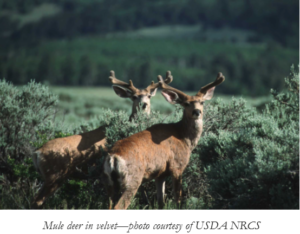 harmful to big game, such as deer, elk, and bear. That’s because the animals can become dependent on unnatural foods sources found in landscaping, crops, or feeds. Feeding wildlife can also cause the animals to congregate and possibly transmit disease through population, create traffic hazards when wandering close to roads, draw them away from their historic winter range, or prevent migration.
harmful to big game, such as deer, elk, and bear. That’s because the animals can become dependent on unnatural foods sources found in landscaping, crops, or feeds. Feeding wildlife can also cause the animals to congregate and possibly transmit disease through population, create traffic hazards when wandering close to roads, draw them away from their historic winter range, or prevent migration.
Wildlife can occasionally become a nuisance. The key to avoiding issues is due diligence in securing homes and outbuildings. Cover window wells with grates or hardware cloth; close holes around and under foundations, sheds, and outbuildings; use locking tops for garbage cans as well as pet or animal food containers; and fence gardens. Bird feeders should not be accessible to other wildlife.
Many birds (except starlings, sparrow, and pigeons) are protected. Shooting or the use of poisons to kill birds and animals is illegal and strictly regulated by the federal and state governments. Contact your local Colorado Parks and Wildlife office for information and advice on how to handle wildlife problems before you take any action.
Raccoons, skunks, and squirrels – Removing tree branches that overhang buildings, capping chimneys, and repairing attic holes will help prevent entry. To prevent them from invading desirable locations, bury wire mesh eighteen inches underground. Raccoons are especially adept at pilfering garbage and pet food containers. Tight fitting lids that clamp or tie down will help if they are tipped over. Take away any food sources that might draw these critters to your home!
Deer and Elk tend to move to lower elevations during winter months often placing them in areas that are populated with homes and roadways. In areas where deer are common, shrubbery and gardens may be damaged, however, deer avoid flower bulbs that have strong odors. Elk and moose tend to avoid human interaction more than deer. At certain times of the year they can be dangerous if interacting with humans because they are extremely protective of their calves.
Bears enter residences in search of food causing potential damage to both themselves and to homes and vehicles. Since a bear’s sense of smell is 100 times more powerful than ours, it helps us to understand how pet food containers, garbage cans, and the smells from last night’s food on the BBQ grill can all bring in the visitors. Take appropriate precautions to bear-proof your property including hanging bird feeders during seasons when bears are hibernating. Using locking garbage canisters, and remove items with sweet odor including candles, etc.
Resources:
Living with Bears
Living with Wildlife
Deer Management for Home Owners
As people encroach further into deer habitat, deer naturally wander into lawns and Gardens. While deer resistant plants are helpful, if deer persistently browse your landscape, you may need to use fence or deer repellents.
Wire mesh fences are more effective than wood, although not generally 100 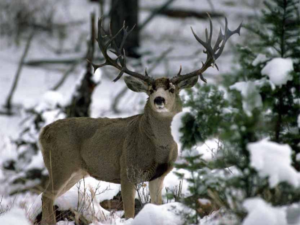 percent effective. Vertical wire Garden fences should be at least eight feet high. Slanted fences should lean away from the Garden at a 30 to 45 degree angle from the ground and should be at least six feet high. This creates both a physical and psychological barrier to deer. Electric fences also can be used.
percent effective. Vertical wire Garden fences should be at least eight feet high. Slanted fences should lean away from the Garden at a 30 to 45 degree angle from the ground and should be at least six feet high. This creates both a physical and psychological barrier to deer. Electric fences also can be used.
Fences protecting individual plants or small groups of plants should be at least four feet high. These enclosures are effective because deer avoid tight, penned-in sites. Garden netting may protect flowerbeds and other low-growing plants.
Tubes placed around the trunks of larger trees will help prevent trunk damage. Tubes will not prevent trunk damage when bucks use the trees to scrape the velvet off their antlers. Fencing trees may help keep deer away.
Effective commercial repellents include Deer-Off and Deer-Away. One of the most effective homemade repellents can be made by whipping one part whole eggs with four parts of water. Apply on a dry day with temperatures above freezing. This egg spray does not readily wash away and is not harmful to plants.
Deer browse from the top of a tree or shrub to the bottom of trees and shrubs. Apply or hang repellents within the new growth. Young trees should be treated completely, but older trees may be treated only on the branch tips. In the fall and winter, treat trees six feet above the maximum expected snow depth. Re-apply the repellent every 30 days.
No repellent will be active forever and deer may get used to egg sprays. When this happens, try other measures and be persistent.
For more information, see the following Colorado State Cooperative Extension fact sheet Preventing Deer Damage available at your local CSU Extension office.
Is Your Fire Wood Infested?
Each fall as we cut firewood and bring it into our homes, we may also be bringing in some unexpected hitchhikers. Fortunately, these shelter seekers pose no danger to humans, our homes, or our furniture. They are either feeding directly on the wood, nesting in the wood, or are overwintering under the bark. Unfortunately, they do create a very visual nuisance crawling around your home.
Because insects generally require several days to warm up in your home before they become active, the best way to prevent the insects from emerging from firewood in your house is to leave the firewood outside until it is to be burned, bringing, at most, a few days’ supply into the house at one time.

Spraying firewood with insecticide is of very little benefit and potentially dangerous. Therefore, I strongly advise against treating firewood. Insecticides will not penetrate deeply enough into firewood to control the insects. In addition, storing and burning insecticide-treated firewood indoors could be a health hazard if the insecticide is vaporized into the living area of the house.
Insect invasion of homes from firewood can be reduced by following these rules:
- Avoid stacking the wood directly on the ground. This will keep the wood from getting too wet and reduce the chances for infestation by termites and ants.
- Don’t stack firewood in or against the house or other buildings for long periods of time. Termite or carpenter ant problems can develop and cause more serious problems.
- Use the oldest wood first, as it is most likely not to be infested. Avoid the tendency to stack new wood on top of old wood.
- Cover the wood during the summer and fall. This will keep it drier and exclude some creatures seeking overwintering sites.
- Shake, jar, or knock logs together sharply to dislodge insects and brush off any obvious structures such as webbing or cocoons before bringing it inside.
- Bring in small amounts of firewood that can be used up in a day or so and keep it stacked in a cool area (e.g., garage or porch) until it is burned. When wood warms up, the creatures in or on it will become active.
- Do not treat firewood with insecticides. It is unnecessary and potentially dangerous due to fumes that may be produced when the insecticides burn.
Insects you might see:
Carpenter ants: Wood that remains moist for an extended period is a likely candidate for infestation by carpenter ants. Carpenter ants hollow out galleries in the wood for nesting. Chances of these ants establishing a nest in your house are very slim.
Termites: Wood that is stacked directly on the ground may be fed upon by termites. Termites brought into your home in firewood will not damage your home or furniture. If you feel you might have termites in your walls or floors (common in Meeker and Rangley), call and I will drop by for a positive identification. These termites enter through cracks in your foundation. They have a queen, moisture, and a place to hide, which is necessary for invasion.
There are several groups of beetles found in the upper White River Valley that feed on wood and can accidentally be brought into your home in firewood. These beetles can be a nuisance if they emerge from firewood; however, none of these beetles will harm your home or furniture.
Longhorned beetles: Attracted to dying, freshly cut, or recently killed trees. The larvae emerge from the eggs and burrow into the tree and spend 1-3 years tunneling through the wood.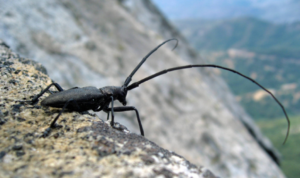 Metallic wood-boring beetles: Called flatheaded borers because they have a large, flattened head. They are similar to the longhorned beetles in that the larvae bore into wood, pupate, and adults can emerge from firewood.
Metallic wood-boring beetles: Called flatheaded borers because they have a large, flattened head. They are similar to the longhorned beetles in that the larvae bore into wood, pupate, and adults can emerge from firewood.
Bark beetles: One of the more common firewood insect found in dead trees. These beetles are small (less that 1/8 inch in length), brown or black and cylindrical. The adult beetles tend to attack wood in groups, so a log cut from a tree that they are feeding on can contain hundreds of individuals.
There are a variety of insects that spend their winters in your wood pile. When you bring firewood into your house and it warms, these insects crawl out of the wood. Pillbugs, spiders, centipedes, millipedes, and ground beetles are commonly found in firewood. They will not harm you or your house and need only be picked up and removed.
Bottom line: Most insects do not cause a problem, but if you see something on the floor simply put it in a glass jar and drop it by the Extension office. We will identify your sample and gladly provide control options.
Safety & Preparedness
Mapping and Emergency Preparedness
Winter Driving
Wildfire
High Water Preparation Guide
Agricultural Safety
Mapping Resources
The Gunnison County, Geographical Information Services (GIS) Department provides geographic data to help people locate, map, and analysis geographic information. The work involves creating and ov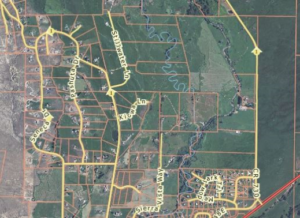 erlaying various layers such as parcels, addresses, and aerial photography within computer software. The result is then made available to people via interactive web maps, printed maps, and special software. It is always a good idea to visit their sites and make sure all parcel and address information is correct.
erlaying various layers such as parcels, addresses, and aerial photography within computer software. The result is then made available to people via interactive web maps, printed maps, and special software. It is always a good idea to visit their sites and make sure all parcel and address information is correct.
Resource:
Gunnison Geographical Information Service
Emergency Preparedness
Preparedness means not only having the appropriate gear and supplies necessary to cope with emergencies, but also having a plan for your family to follow in these situations. An important component of this plan should be how family members would communicate, keeping in mind that in some circumstances, regular phone service and cell phone service may be unavailable. Below are several links to information on emergency preparedness for you, your family, and your pets:
Resources:
Gunnison County Emergency Management
American Red cross Emergency preparedness
Ready Colorado
Gunnison County Emergency Manager
Ph: 970-641-2481
Fx: 970-641-7693
(voicemail is available 24 hours/day)
Winter Driving
Winter driving in Western Colorado means snow, sleet, and ice that can lead to slower traffic, hazardous road conditions, hot tempers, and unforeseen dangers. To help you make it safely through winter, here are some suggestions from the National Safety Council to make sure that you and your vehicle are prepared.

Weather
At any temperature — 20 degrees Fahrenheit below zero or 90 degrees Fahrenheit above — weather affects road and driving conditions and can pose serious problems.
It is important to listen to forecasts on radio, TV, cable weather channel, or forecasts in the daily papers.
Your Car Prepare your car for winter. Start with a checkup that includes:
- Checking the ignition, brakes, wiring, hoses and fan belts.
- Changing and adjusting the spark plugs.
- Checking the air, fuel and emission filters, and the PCV valve.
- Inspecting the distributor.
- Checking the battery.
- Checking the tires for air, sidewall wear and tread depth.
- Checking antifreeze level and the freeze line.
- Your car should have a tune-up (check the owner’s manual for the recommended interval) to ensure better gas mileage, quicker starts and faster response on pickup and passing power.
Necessary Equipment
An emergency situation on the road can arise at any time and you must be prepared. Following the tune-up, a full tank of gas, and fresh anti-freeze, your trunk should carry:
- A properly inflated spare tire, wheel wrench and tripod-type jack
- A shovel
- Jumper cables
- Tow and tire chains
- A bag of salt or cat litter
- Tool kit
Essential Supplies
Be prepared with a “survival kit” that should always remain in the car. Replenish after use. Essential supplies include:
- Working flashlight and extra batteries
- Reflective triangles and brightly-colored cloth
- Compass
- First aid kit
- Exterior windshield cleaner
- Ice scraper and snow brush
- Wooden stick matches in a waterproof container
- Scissors and string/cord
- Non-perishable, high energy foods like unsalted canned nuts, dried fruits, and hard candy.
- Heavy woolen mittens, socks, cap, blankets
If You Become Stranded:
- Do not leave your car unless you know exactly where you are, how far it is to possible help, and are certain you will improve your situation.
- To attract attention, light two flares and place one at each end of the car a safe distance away. Hang a brightly colored cloth from your antenna.
- If you are sure the car’s exhaust pipe is not blocked, run the engine and heater for about 10 minutes every hour or so depending upon the amount of gas in the tank.
- To protect yourself from frostbite and hypothermia use the woolen items and blankets to keep warm.
- Keep at least one window open slightly. Heavy snow and ice can seal a car shut.
- Eat a hard candy to keep your mouth moist.
Wildfire
The Wildland Urban Interface (WUI) is defined as the area or zone where structures and other human development meet or intermingle with undeveloped lands or vegetative fuels. Wildfires in the WUI are very real and pose a potentially disastrous situation. No area is immune from the threat of wildfire and this is particularly true within the WUI.
To reduce the risk of wildfire the following measures are recommended:
- Thin out continuous tree and brush cover within 30 feet of your home to create “defensible space” around the home site. Ensure tree crowns are spaced at least 10-12 feet apart.
- Homes located on a slope need to have an enlarged defensible space on the downhill side.
- Prune branches from trees within the defensible space to a height of 10 feet above the ground. Remove shrubs, small trees, or other potential “ladder” fuels from beneath trees.
- Remove dead limbs, leaves, and other ground litter within the defensible space. Dispose of all slash and debris left from thinning by removal from site, lop and scatter, or chipping.
- Maintain an irrigated greenbelt adjacent to the home using grass, flower gardens, or ornamental shrubbery. Use rock as mulch, avoid bark or wood chip mulch in this area.
- Mow or graze dry grasses and weeds and irrigate the area during periods of high fire danger.
- Clean roof and gutters of pine needles and leaves to eliminate a potential ignition source.
- Stack firewood uphill and at least 15 feet away from your home.
Wildfire Quick Facts
- Wildfires occur in ALL seasons of the year.
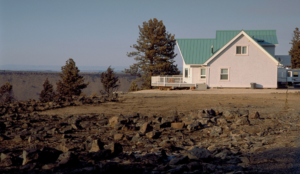
- Wildfires occur in grass, brush, and trees.
- Wildfires occur in all sizes and locations.
- Wildfires move with incredible speed!
The action taken now to implement a defensible space project can help to protect your home in the future. Contact your local fire district or Colorado State Forest Service office for help.
Resources:
Forest Home Fire Safety. CSU Ext. Factsheet 6.304
Living with Fire: A Guide for the Homeowner. CSFS
Protecting Your Home from Wildfire: Creating Wildfire-Defensible Zones. CSFS
High Water Preparation Guide
Am I in a risk area:
● Do you live in a low-lying area susceptible to high water?
● Do you know enough about high water risk?
The severity of local high water, and whether or not major high water occurs along tributaries, creeks and rivers in Gunnison County, depends mostly on the weather conditions during snowmelt in May and June. The weather determines when and how rapidly snowmelt occurs. Unusually high snowpacks naturally raise the possibility of high water, but risk is determined by a combination of events and conditions:
Heavy, concentrated rain events
Heavy rains mixed with spring’s melting snow, creating excessive run-off into rivers and creeks Ice jams – water upstream is blocked by ice downstream.
Remember that if rising waters become a threat to your safety, follow the instructions of local emergency officials who are involved in rescue or high water response operations, including those directing traffic, as water can be deeper than it appears. Keep disaster response routes clear.
Before a high water emergency: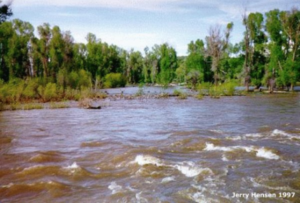
● Know if you live in a high water-risk area.
● Purchase flood insurance, if desired.
● Prepare personal emergency supply kits for your home, car and work.
● Have a grab-and-go kit ready if you have to leave your home quickly.
● Keep important papers in watertight containers and have a record of your valuables in a safe place to help with insurance claims.
● Choose a relative or close friend out of the area as a contact person for family members and friends.
● If high water is likely in your area, pay attention to
the local media for information.
● Watch for warning signs: increase in height and intensity of water flows, mudslides, debris in creeks, color changes in water, or leaning trees.
● Know that banks of rivers and streams may be unstable and dangerous.
● Teach your children about high water safety.
● Consider arrangements for your pets and any livestock.
● Check on elderly or disabled neighbors to ensure they are aware of the situation.
● Prepare an evacuation plan from your home to a safe area.
Agricultural Safety
Each year, several hundred farmers and farm workers die from work-related injuries, and tens of thousands more are injured in the United States. Many of these deaths and injuries are preventable by implementing safe working and operating procedures at the farm.
Machinery
In Colorado, most of the agriculture-related fatalities are attributed to the operation of
machinery, including tractors. Other major causes of fatalities result from electrical accidents (12%); injury by animals (8%); drowning (7%); and chemicals (2%). Prevention starts by:
- Knowing how to operate machinery safely, and applying those safety practices;
- Being cautious and alert around animals;
- Safe chemical use, including safety gear;
- Locating power lines before moving augers and irrigation pipes;
- Restricting children from equipment and irrigation canals; and
- Never allowing passengers on tractors unless a seat is provided.
Roll-overs are common when tractors are not properly operated. Always drive down hill with conventional-style tractors (rear wheels larger than front wheels) where 35% of the weight is in the front; 65% is in the rear. Newer tractors are equipped with a rollover protective structure (ROPS). Always operate ROPS-equipped tractors with the seatbelt fastened. Only non-ROPS or non-roll-bar-equipped tractors can be operated without a seatbelt; however, ROPS devices are available for older tractors. Only one tractor death has been reported for an operator wearing a seatbelt with a properly-installed ROPS. Deaths are reported, however, for ROPS-equipped tractors whose operators did not wear seatbelts. It is more dangerous to not wear a seatbelt with ROPS than to have no ROPS at all.
Livestock
Livestock safety involves calm, quiet, and careful handling to reduce the handler’s injury
potential. Animals are not always predictable, so accidents can happen. Keeping livestock calm reduces the chance they will react to outside influences. Intact males often have a greater potential to harm handlers than do other animals. Never allow small children in pens with intact any type of livestock. Horses generally injure and kill more people than do other types of livestock. Young or inexperienced riders should wear a riding helmet, as should experienced riders. Safety on the farm or ranch begins with common sense. Focus on the task at hand, and take frequent breaks to reduce mental or physical fatigue.
Animal Management
Livestock
Beef Cattle
Brand Inspection
Horses
Chickens
Pigs
Sheep
Goats
Waste Management
Livestock
One of the first things to consider when entertaining the idea of raising domestic livestock is whether the enterprise you are considering is compatible with the community you live in. Is your property zoned for large animal production? How many animals can you legally have? How will your neighbors react to your project?
Some acreages are suitable for pasture production. If you have irrigation water available you might be in a situation where you can handle a relatively small number of domestic livestock to meet your lifestyle needs. A corral, or dry lot, must be available to keep the animals in when irrigating, and when the pasture needs a rest from grazing. Corrals are also essential if you are finishing cattle on grain rations. If there is adequate acreage, you might consider farming and raising some of your own feed. Realize that it is expensive to own and maintain equipment. It may not be economically feasible to own equipment, although bringing in custom operators may be an option that can work for you.
The following pages are dedicated to giving you a sample of some of the considerations for raising the domestic livestock that are common to our area. For further information, consult your local Extension Agent or visit one of the web resources that follow.
Beef Cattle
The largest agricultural enterprise in Western Colorado is raising cattle. Cattle are ideal for the small acreage land owner and nationally the average herd size is 25 cows. Also, cattle can be a great tool to help manage a sensitive small-acreage ecosystem. Two basic beef cattle operations are cow/calf and 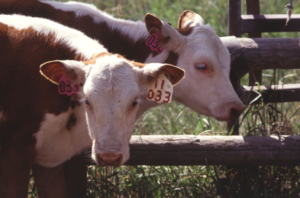 weanling/yearling enterprises. Cow/calf enterprises operate year-round, with calves as the primary product. Weanling/yearling enterprises purchase weaned calves or yearlings and graze them only for summer gain; or feed them out for meat. While these are indeed the two typical commercial systems for beef production, we now are seeing more and more small-acreage landowners totally integrated who are producing calves and raising them for the purpose of their own freezer or a local market. These cow/calf enterprises can be commercial or registered. Registered cow/calf enterprises produce breeding stock; commercial cow/calf enterprises produce calves.
weanling/yearling enterprises. Cow/calf enterprises operate year-round, with calves as the primary product. Weanling/yearling enterprises purchase weaned calves or yearlings and graze them only for summer gain; or feed them out for meat. While these are indeed the two typical commercial systems for beef production, we now are seeing more and more small-acreage landowners totally integrated who are producing calves and raising them for the purpose of their own freezer or a local market. These cow/calf enterprises can be commercial or registered. Registered cow/calf enterprises produce breeding stock; commercial cow/calf enterprises produce calves.
Beef Cattle
Beef Cattle Products
There is no one breed that is best! Instead of selecting a breed, beef cattle producers should select a biological type that is compatible with their existing environment and consider production and marketing goals. Because of their ability to take low quality renewable resources and transform them into high quality protein products, cattle are a great value to our food system.
The typical beef animal spends 11 to 12 months of its life grazing grassland and then 3 to 4 months on a high energy diet finishing before slaughter. This high energy diet efficiently increases the tenderness and flavor of the final beef product. Another product gaining popularity is grass-fed beef. In a grass-fed operation cattle forgo the high energy diet and continue on a forage-based diet for another 8 to 10 months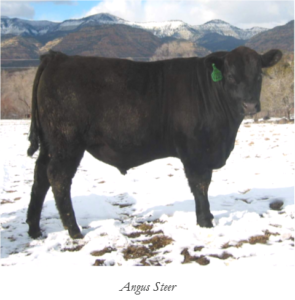 before slaughter.
before slaughter.
Cattle performance and carrying capacity are related to, and affected by, forage production and quality. Feed cost directly impacts profitability. It is extremely important that producers evaluate the cow herd’s nutritional needs versus available forage resources. Carrying capacity and cattle performance are not easy to predict, and will change from month to month. Contact your local Extension office for more information on pasture management, cattle nutrition, and performance.
Resources:
Colorado State University Beef Page
CSU Ext. Veterinary Information
Brand Inspection
The following items are a highlighted overview of the requirements to purchase, sell or transport livestock within Colorado, or from the state. Also included are a few pointers when purchasing livestock in other states that will be transported into Colorado.
Employees of the State Board of Stock Inspection are charged with the  protection of the Colorado livestock industry. This entity must certify that the shipper or seller is the legal owner prior to issuing a certificate. All lost, missing, stray or stolen livestock fall under the jurisdiction and control of the State Board.
protection of the Colorado livestock industry. This entity must certify that the shipper or seller is the legal owner prior to issuing a certificate. All lost, missing, stray or stolen livestock fall under the jurisdiction and control of the State Board.
Things to Remember
- Inspection is required for the sale or movement of livestock, even if the previous parties did not comply the last time the animal was sold or transported.
- Inspection is required regardless of whether or not the animal is branded.
- Inspection is required on all classes of livestock. Registration papers, or lack of registry, does not exempt inspection.
For the purposes of this article, the definition of a brand a permanent mark on the hide of an
animal registered with any state as a livestock brand. (Tattoos are not brands.)
Inspection is required at the point of origin, unless released by the local inspector.
Regulations
Additional information regarding exact regulations can be obtained from the Division of Brand Inspection, State Board of Stock Inspection Commissioners (Brand Board), a section of Colorado’s Department of Agriculture.
Information About Out-of-State Livestock Purchases
When purchasing animals in states other than Colorado, be sure to check that state’s requirements concerning inspection prior to the purchase and transport of livestock back to Colorado.
Several states do not have an inspection law and, therefore, a certified inspection cannot be obtained. Always get a valid bill of sale and a health certificate when purchasing animals in no-inspection states. This needs to include a complete description of stock being purchased, including number of head, color, sex, breed, markings, registration numbers and hot iron brands among other pertinent information.
Resources:
Office of the State Board of Stock Inspection Commissioner
www.colorado.gov/ag
Horses
Many land owners buy their small acreages solely based on the ability it gives  them to own a horse. However, owning and caring properly for a horse is a large and expensive responsibility. Careful thought and consideration should always be taken into account before purchasing a horse. The average cost in the United States to maintain a horse is $3.17 per day ($1,200.00 per year). This includes feed and veterinary services. Feed will cost a minimum of $400.00 per year. If you include facilities, tack, transportation, depreciation and interest, then the average cost is $6.75 per day ($2,500.00 per year). If you plan to show or hire a professional trainer, additional funds will be needed. Your initial investment is the cheapest part of owning a horse.
them to own a horse. However, owning and caring properly for a horse is a large and expensive responsibility. Careful thought and consideration should always be taken into account before purchasing a horse. The average cost in the United States to maintain a horse is $3.17 per day ($1,200.00 per year). This includes feed and veterinary services. Feed will cost a minimum of $400.00 per year. If you include facilities, tack, transportation, depreciation and interest, then the average cost is $6.75 per day ($2,500.00 per year). If you plan to show or hire a professional trainer, additional funds will be needed. Your initial investment is the cheapest part of owning a horse.
Buying a Horse
When buying a horse, first you have to decide what you want. First-time buyers should look at purchasing a four-year-old, or older, well broke or started, and trained gelding or mare. For pleasure and leisure riding, avoid ponies, which are horses less than 14 hands tall, and also avoid draft breeds. Common breeds to ride found in the Western Colorado area are Arabian, Appaloosa, Morgan, Paint, Pinto, Quarter Horse and Thoroughbred. However, a grade horse (not registered) may also fit your needs. A registered horse is beneficial if you intend to breed or show the horse. Purchase your horse from a reputable breeder or trainer. Ask many questions and then some, because very few horses come with a guarantee. Also, once a horse is brought home and placed in a different environment, its behavior can change.
Facilities and Fencing
Proper shelter for your horse is recommended. A two or three-sided wind shelter with a roof may be adequate, even in cold climates. You may opt for a complete barn with box stalls (at least 12ft X 12ft), a tack room and a feed room. A number of fencing materials are suitable for horses including Poles, rails, or boards for smaller areas, such as paddocks. For pasture areas consider using smooth wire, woven wire, or electric fencing. Avoid barbed wire or large hole woven wire. Electric fencing is economical and convenient, especially for dividing irrigated pastures. Well-maintained fencing is an indicator that you really care for your animals.
Feeding
The average horse in good physical condition will consume one and one-half to two percent of its body weight in air dry feed per day. For example, a 1,000-pound horse can consume 15 to 20 pounds of feed per day. Most light work horses will get along nicely on good quality grass or alfalfa hay. Other supplements are usually not necessary, except for pregnant and lactating mares, young horses (aged two years or less), hard working, and geriatric horses.
Poisonous or Toxic Plants
Horses are less likely to eat poisonous or toxic plants than cattle and sheep. However, there are several species that are of concern, including lupine, milkweed, and Russian knapweed. It should be noted that overgrazing is the most common cause of toxic plant problems in horses.
Resources:
CSU Ext. Veterinary Information
Chickens
Managing a home flock of birds can be rewarding and the entire family can participate in caring for the flock. Successful management begins with planning. For that reason, you need to make several decisions before you start your flock including the desired size of your chicken flock. This mainly depends on how many eggs a day you wish to have. Most breeds will produce around 200 eggs per year. Typically a hen will lay one egg per day during the longer days and are less consistent during the winter months. If a family wishes to have three to four eggs per day, then they would need six hens. If you wish to sell them, you would need additional hens.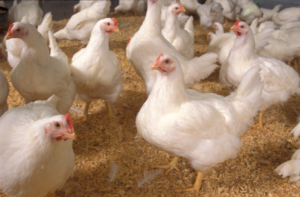
Facilities to House Chickens
Housing is one of the most crucial factors in proper care for your chickens. Chicken houses, runs, and yards are as diverse as the people who raise them. Some considerations should include: is it rodent and predator proof; is it easily cleaned, disinfected, and maintained; does it provide proper ventilation and shelter from the harsh elements; is there plenty of room for feed, water, nesting boxes, and roosts. Construction and fencing should be carefully considered to prevent predators such as skunks, raccoons, foxes, hawks, owls, and the neighbor’s dogs. Coops should have closed floors and the fencing around covered runs should be buried at least 12 inches in the ground. Coops should be kept clean and disinfected, proper ventilation is a must for your coop. During the winter months, coops should be insulated from wind and cold. Also, heat lights can be used to add extra warmth and heated water can prevent ice. Each laying hen needs 2 to 3 square feet of floor space in the coop. You will need 1 nesting box per 2-4 birds. Roosts should allow 12 inches per bird and be higher than the nesting boxes. If you have a run outside, it should be twice as big as the coop. Covered protective runs are great when owners cannot keep a watchful eye over their chickens. One chicken, will eat 6 to 10 lbs of feed per month. Feed and water should be raised off the ground, filled and cleaned daily. Be sure to collect eggs at least twice daily to prevent dirty, broken, or frozen eggs. Clean dirty eggs with water that is warmer than the egg itself. Also, refrigerate eggs to maintain quality.
Caring for Baby Chicks
Purchase chicks from a commercial hatchery or reputable breeder. Chicks from this source are generally free of disease and vaccinated for Marek’s disease. Raising your own chicks is not that difficult, but you will need additional equipment: heat lamp, chick waterer, chick feeder and a protective area (livestock troughs work well).
Resources:
Small and backyard flocks
Pigs
Contrary to stereotype, pigs are the cleanest and smartest of all farm animals. They require little space and can produce an average of 150 pounds of pork products in five to six months. They do however grow quite large and while a 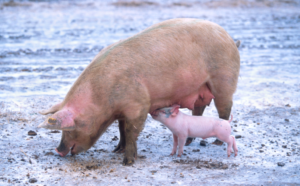 finished market hog may only weigh 250 lbs, a two-year-old sow can weigh 500 lbs. Most pigs are cross-breeds, for improved heterosis. Hampshire, Berkshire, Duroc and Landrace are meat breeds; Yorkshires are known for their maternal traits. Buy at least two pigs of similar age and weight at a time, preferably from a single source. Pigs are weaned at about four weeks of age; sold at six to eight weeks; and should weigh 20 to 30 pounds at six weeks; and 30 to 40 pounds at eight weeks. Piglets should be eating dry food on their own at six weeks.
finished market hog may only weigh 250 lbs, a two-year-old sow can weigh 500 lbs. Most pigs are cross-breeds, for improved heterosis. Hampshire, Berkshire, Duroc and Landrace are meat breeds; Yorkshires are known for their maternal traits. Buy at least two pigs of similar age and weight at a time, preferably from a single source. Pigs are weaned at about four weeks of age; sold at six to eight weeks; and should weigh 20 to 30 pounds at six weeks; and 30 to 40 pounds at eight weeks. Piglets should be eating dry food on their own at six weeks.
Facilities to House Pigs
Simple housing is sufficient if pigs purchased in spring are butchered prior to winter. However, build a good solid fence, or use electric fence. Once trained, pigs will respect the wire. Electric fence is portable; however, it may be a problem for young pigs, because the wire must be low to the ground. Two strands may be necessary for young pigs. The bottom wire should be a bit lower than snout height; the top wire a bit lower than the pigs’ height. Adjust wire height as needed to accommodate piglets’ rapid growth. Fences must be four feet high. A 200-pound pig can scale a lower fence. For young pigs, space boards four inches apart or less. Pigs root, so bottom boards must be buried six inched deep to prevent rooting under the fence. Pigs need shade to prevent overheating and sunburn. Elaborate structures are not needed, but dependable shade is a requirement. Pigs need 1.5—2 feet of feeding space each. Use a non-tipping feeder, since pigs love to turn their dishes over. Self-feeders and self-waterers designed for pigs are commercially available, and offer constant supplies of food and water.
Feeding
Pigs need a balanced diet, much like humans, including proteins, carbohydrates, fats, mineral salts, vitamins, and water. Most commercial pig feeds are “complete” feeds, containing all the essentials needed. Two pigs will grow faster and more economically than one. From weaning to processing weight, you will need 600 to 1,000 pounds of commercial feed.
References:
Hogs, pigs and pork
Sheep
Sheep production is popular in western Colorado. Sheep are well-suited to this area, and provide two crops: lamb (meat) and wool. First determine the carrying capacity of your acreage; then determine your market goals. Market options include: freezer lambs, breeding stock, weaned lambs or wool. The desired marketing option determines the breed or breeds you will select. If wool production is your goal, choose a fine wool breed, such as Rambouillet or Merino. These breeds are rugged, adaptable, have a long breeding season and excellent herding instincts, and are long-lived; but they do not produce a 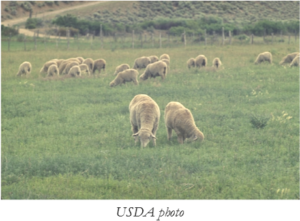 heavily-muscled carcass. If your goal is both wool and meat, select a medium wool breed, such as Columbia, Targhee or Polypay. Medium wool breed lambs grow faster and have better body conformation, as well as good herding instincts; however, they require more feed and have a shorter breeding season than fine wool breeds. Meat breeds were developed primarily for lamb production, and populate many farm flocks. Suffolk and Hampshire are the most popular meat breeds. The advantage of meat breeds is that the lambs have excellent body conformation; blackface ewes, however, produce a light clip of wool and are later breeders.
heavily-muscled carcass. If your goal is both wool and meat, select a medium wool breed, such as Columbia, Targhee or Polypay. Medium wool breed lambs grow faster and have better body conformation, as well as good herding instincts; however, they require more feed and have a shorter breeding season than fine wool breeds. Meat breeds were developed primarily for lamb production, and populate many farm flocks. Suffolk and Hampshire are the most popular meat breeds. The advantage of meat breeds is that the lambs have excellent body conformation; blackface ewes, however, produce a light clip of wool and are later breeders.
Facilities to House Sheep
Sheep need protection for the flock during wet and cold weather, and ewes and lambs need a dry, draft-free shelter for lambing. A shed or barn with a dirt floor that opens to the south makes a good sheep shelter. Provide the best fences you can for your sheep to help reduce predation by coyotes and dogs. Predator control animals can be utilized effectively, however careful considerations should be considered. Guard dogs can be a great tool in large pastures however, they can be a threat to neighbors bordering small pastures. Lamas and donkeys are also good predator control animals as long as they aren’t a nuisance to neighbors or visitors. Sheep take less labor than other livestock, and do well with low-cost housing and equipment.
Feeding
Sheep can generally meet their nutrient requirements by utilizing high quality pasture. During the winter, a ewe can be maintained on three to three and one-half pounds of good-quality hay daily. During the last six weeks of pregnancy, additional nutrients are required.
Resources:
Sheep
Goats
Increasingly goats are finding their homes in rural western Colorado as well as urban areas. Much of the popularity of these small ruminants is because of their low maintenance size and ability to utilize very low quality browse and weeds. In fact, many weed control districts are even using them as management tools. There are three types of goats found in the United States: fiber, dairy, and meat goats. The key management issues for a successful goat enterprise are fencing, parasite control, predator control and marketing.
Types of Goats
Meat goats fit in well with other enterprises, particularly cattle operations, and may be used to control noxious weeds and brush to improve pastures for other livestock. The increasing economic importance of meat goat production in the United States can be attributed both to a strong demand for goat meat, and to an interest in ecologically-sound forms of vegetation control. Meat goats can be raised with very little supplemental grain, and with minimal shelter, and are generally an easy-care animal.
Dairy goats also fit well into operations where milk is a desired product. If milk production is important, feed maximum amounts of high quality hay balanced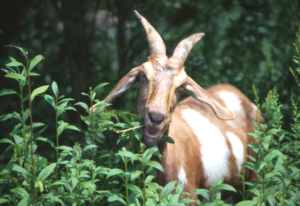 with a grain ration containing enough protein, minerals and vitamins to support production and animal health. Many local markets are finding favoritism with locally produced artisan cheeses and many people with lactose intolerance are finding goats milk a great alternative to cow’s milk.
with a grain ration containing enough protein, minerals and vitamins to support production and animal health. Many local markets are finding favoritism with locally produced artisan cheeses and many people with lactose intolerance are finding goats milk a great alternative to cow’s milk.
Fiber goats are also popular in Colorado due to many people loving the natural fibers like Cashmere and Angora. Cashmere goats produce a very fine down undercoat that can be brushed out and is extremely soft. Angoras produce Mohair, a product that can be shorn twice a year and is more durable, warmer and less inclined to shrink than sheep wool.
Facilities to House Goats
Housing needs for goats are very simple and, in moderate climates, may consist of natural cover, such as thick trees and brush, or rock ledges. Goats do, however, need protection from rain, cold wind and snow. A sturdy shed open to the south, with a rear eave height of four to six feet and a front eave height of six to eight feet will help conserve body heat. For night shelter, allow five square feet per goat.
Resources:
Meat Goat
Dairy Goat
Waste Management
 Why Manage Manure?
Why Manage Manure?
Manure can be a valuable resource but can also be a source of water pollution, odor, flies, parasites, and other nuisances. If not properly managed, manure can contaminate drinking water, harm wildlife, and reduce property values. Mud and manure can cause abscesses, thrush, and other diseases in livestock. Dried manure produces molds that contribute to respiratory problems in horses and cattle. By adopting simple and low cost best management practices (BMPs) for storing, handling, managing and utilizing manure, the environment and health of farm animals will benefit. Lost nutrients can contribute to water pollution. Manure nutrients can be lost through erosion, water run-off, volatilization, and even leaching.
Best Management Practices (BMPs)
- Divert clean water away from manure:
-Construct berms or terraces and use downspouts to divert clean water. - Ensure manure discharge will not enter a water body or leave the property:
-Collect manure frequently.
-Limit animal access to ponds, streams, ditches, and wetlands.
-Stockpile manure at least 100 feet outside a floodplain. - Protect ground water:
-Locate manure storage piles and livestock corrals at least 150 feet down-gradient wells.
-Use a 150 foot buffer around wells when land applying manure. - Reduce nuisances like flies and odor:
-Stockpile manure downwind from barns and 200 feet away from neighbors.
-Remove manure from corrals and pens often to prevent flies, parasites, and worms.
-Cover fresh manure in stockpiles with at least 5” of clean bedding, straw, or hay.
Disposal Options
- Dispose off-site to a landfill or hire someone to pickup and dispose of manure.
- Compost manure. This requires the right ratio of carbon (bedding) and nitrogen (manure). Try 30:1 (C:N) ratio, water to keep the pile moist and aerate the pile regularly.
- Spread manure in spring or summer. Test manure for nutrient content and spread based on soil test recommendations. Unused nutrients pollute water bodies and groundwater.
Home & Garden
Gardening at High Altitude
Plant Selection
Starting a New Lawn
Water Conservation
Home Storage of Foods
High Altitude Food Preparation
Food Safety & Storage
Mildew in Your Home
Gardening at High Altitude
Gardening in the mountains in Colorado presents unique challenges. Temperature is not the only factor that determines plant survival. Intense sunlight, low humidity, short growing seasons, desiccating winds, extreme weather fluctuations, difficult soils, recurrent drought and wildlife damage present challenging conditions for growing plants.
Soil Properties
Common soil issues include poor aeration as seen in clay soils; low organic 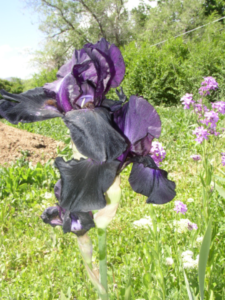 matter and nutrients as seen in decomposed granite; and hard to plant areas due to rocky soils. Some soils have a high pH and can create nutrient deficiencies in plants. Colorado soils are often high in iron but yellowing symptoms of iron deficiency are common because high calcium in the soil “ties up” the iron making it unavailable to the plant. Therefore, choose plants that will do well with existing soil conditions, improve the soil, or plant in raised beds and containers.
matter and nutrients as seen in decomposed granite; and hard to plant areas due to rocky soils. Some soils have a high pH and can create nutrient deficiencies in plants. Colorado soils are often high in iron but yellowing symptoms of iron deficiency are common because high calcium in the soil “ties up” the iron making it unavailable to the plant. Therefore, choose plants that will do well with existing soil conditions, improve the soil, or plant in raised beds and containers.
Short Growing Seasons
Growing seasons tend to be shorter at higher elevations. Lower valley floors often have even shorter seasons due to cold air drainage from surrounding mountains. The air drainage phenomenon can make a difference in location of a garden as well. Avoid placement of hedges, fences and other landscape features that may obstruct the flow of air. Cooler night temperatures also delay the maturity of vegetables and flowers.
Extreme Weather Fluctuations
It is not uncommon for mountain communities to have an already short growing season interrupted by a killing frost. The real plant killers, however, are the infrequent but rapid changes in temperature. Temperature swings can leave scars on trees and shrubs for years, and serve to eliminate many plants with borderline hardiness. Heavy, wet snows can also occur in spring or fall. When that happens, trees, shrubs and garden flowers are caught in full leaf, or just at the peak of bloom. These snows are “limb-breakers” often causing damage that increases the susceptibility for insects and diseases and can leave permanent scars.
The Brighter Side
Mountain gardeners might want to throw up their hands and say, “What’s the use?” But there is a brighter side. Colorado’s high intensity mountain sunlight gives stronger stems and brighter flower colors. The short growing seasons in the mountains means there is no ‘dead season’ and because temperatures are cooler in the summer in the mountains, the season for cool season flowers and vegetables is extended. Colorado’s semi arid climate means there are fewer insect and disease problems. By understanding and using microclimates to advantage and careful selection of plants, we can have colorful garden flowers, vegetables, and hardy trees and shrubs.
Plant Selection
Appropriate plant selection means choosing plants that not only are compatible with the landscape but also are well suited to the site and local growing conditions. Plants that are well adapted to the soil type, sunlight, annual temperatures and water availability of the site will have a better chance of thriving than those that are not. In most areas of Colorado, plants will require some level of irrigation especially for establishment. It is very important to plan ahead for the water needs of your plants. Drought tolerance is an important consideration, but it should not be the only criteria used to select plants. Junipers, for example, are extremely drought tolerant, but they cannot tolerate poorly drained soils or dense shade.
 Native plants are not necessarily the most drought tolerant. In general, higher elevation natives will require more water than lower elevation natives, and they may be adapted to different soil types. For example, aspen is a native but it does not thrive in the lower valleys with their hot summers. Native plants in a garden do not behave like they would in nature, and are not maintenance-free.
Native plants are not necessarily the most drought tolerant. In general, higher elevation natives will require more water than lower elevation natives, and they may be adapted to different soil types. For example, aspen is a native but it does not thrive in the lower valleys with their hot summers. Native plants in a garden do not behave like they would in nature, and are not maintenance-free.
If you are looking for shade trees, there are many varieties available, both evergreen or deciduous trees that will best meet your needs. Avoid planting a tree that is abundant in your neighborhood; monocultures are more susceptible to insect and disease problems than mixed plantings. Avoid problem trees; Siberian elm, and Russian-olive.
Other important criteria to consider include:
- Mature size: Will the plant remain in scale with the rest of the landscape as it matures?
- Growth rate: Slow-growing dwarf plants require little pruning, but are slow to mature.
- Texture: Does the leaf texture (fine, medium or coarse) combine well with adjacent plants?
- Color: Is the flower/foliage color compatible with other plants or the color of the building?
- Functional use: Is the plant suitable for the location and intended purpose?
Select healthy, vigorous plants. Examine the root system for well-developed roots throughout the root ball and an abundance of small white roots (absorptive roots) along the exterior of the root ball. Avoid plants with girdling roots. Examine the leaves, stems, and trunk for insects, diseases or damage. Consider planting smaller diameter trees, under two inches caliper, they will establish more rapidly and will outperform large caliper trees within three or four years.
Resources:
Trees and Shrubs for Mountain Areas
Starting a New Lawn
Beautiful green lawns are the product of good management. Attention should be given to proper establishment, mowing, fertilization, and watering. Your weed and disease problems should be minimal with proper care. Contact your local Colorado State University Cooperative Extension Office for more information concerning various management recommendations.
Attention to soil preparation before seeding or sodding a lawn will help assure satisfactory results and help reduce your water bill. Before establishing a lawn, remove all debris such as rocks and building materials. The top 8 to l2 inches of soil should be free of any large debris.
Grade the lawn area so it slopes away from the house. Thoroughly soak excavated areas such as around sewer and water lines and over septic systems to settle the fill dirt. After the fill areas are settled, add topsoil. Make sure all topsoil is free from salt or alkali. Repeat soaking and filling until the surface is level.
For this area, add one inch of well rotted horse manure (cattle manure tends to compact too much and is salty) and wood shavings. Thoroughly work this material deeply into the soil (8 to 10 inches). Then add another l-2 inches of wood shavings and work this in.
For heavier soils, it’s good to add 2-5 inches of sand whenever possible. Sand should be washed to remove salt and silt. Sand needs to be round particles, not crushed, as round particles won’t compact as easily.
All fill material should be selected by its cleanliness and absence of alkali or salt.
During soil preparation, work 5 to 10 pounds of available phosphate per l,000 square feet into the soil. This will help supply phosphorus to the deeper growing turf grass roots. Soils prepared in this manner require less water and are healthier.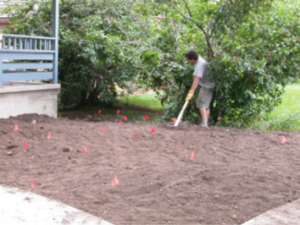
Watering a day or so before finishing the soil preparation will help eliminate large, hard clods. Soil should be well worked and left firm, but not packed, prior to turf establishment. If walking over the lawn site leaves footprints greater than l inch deep, firm the soil with a roller.
Quality is the prime consideration in buying seed or sod. Planting cheap seed mixtures or cut-rate sod often results in a poor lawn. Although varieties of Kentucky Bluegrass would work fine in some areas, it is not very hardy in areas with a high salt content. For alkali or salty areas use Tall Fescue, Red Fescue and Perennial Rye grass varieties. These varieties are drought tolerant and very good for dry rocky soils; yet still develop a very attractive lawn. Lawn mixes that contain large amounts of annual rye grass should be avoided.
Frequent, light watering’s, as many as three or four a day, during warmer periods, are necessary until the seed germinates. This may take two weeks or longer depending on the weather.
If the decision has been made to sod the lawn, remember that sod is perishable. Sod should not be left rolled up or folded for more than a day in warm weather.
Check the soil before laying the sod. If it is dry, sprinkle it lightly. Lay the first strip of sod in a straight line and the next strip as tightly against the previous strip as possible. Think of it as laying bricks for a wall. Roll the sod after first using a light roller to help firm and smooth the surface.
Soak the sod as soon as possible after laying. Turn back a few corners to make sure water has penetrated the sod. Water to keep the new sod damp but not wet.
One problem that faces many when they lay sod is the inability of the grass roots to penetrate the soil. In order to avoid this, make sure that the soil beneath the sod is of lighter texture than the soil in the sod. Numerous cases exist where the roots from the sod, after several years, still have yet to penetrate the base soil.
Avoid walking on new lawn as much as possible. Keep footprints to a minimum by temporarily laying boards on the surface of the lawn to support all foot traffic.
Mow the new lawn when the grass reaches a height of 2 to 2.5 inches.
Avoid the use of herbicides until after mowing the lawn for at least two, and preferably three times.
After the grass has been established, the use of either a liquid or solid fertilizer can be used. Apply at the rate of 1/2 pound of available nitrogen per 1000 square feet, as needed, usually every four to six weeks.
Water Conservation
Irrigation and Your Lawn
The greatest source of water consumption, after that of the domestic water used inside, is your lawn. Nearly 50% of the water consumed for residential use is applied outdoors. Save water by:
- Do not use sprinklers when there is high wind blowing.
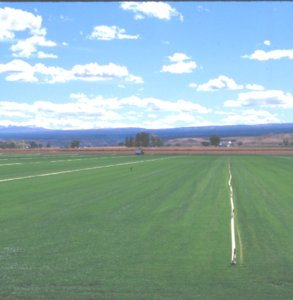
- A heavy rain means you do not have to water at all.
- Water your lawn every third day.
- Determine the irrigation amount and duration.
- Always water during the cool time of the day. Early morning is best. Avoid the peak water consumption hours (4pm-9pm).
- Adjust your automatic sprinkler settings to meet your needs.
- Consider installing drip or micro irrigation.
Water Conservation
Xeriscaping (pronounced “Zeer-eh-scaping”) is landscaping adapted to the semi-arid and arid climates of the Western Slope of Colorado. Natural precipitation is extremely limited in our area where we may receive less than 10 inches annually. Compare that to more than 30 inches of rain New England receives in a typical year, or 70 inches Mississippi typically receives and you will understand why we cannot grow the same Kentucky Bluegrass lawns so often seen in the East. When installed correctly, xeriscaping can save up to 30 percent on home water bills.
Xeriscaping incorporates the following basic principles:
- Limit your turf area. Consider planting warm season grasses (Buffalograss) for their drought-tolerance and ability to survive with minimal fertilizer. Avoid fine and tall fescue grasses.
- Maintain taller grasses, and leave the clippings on the lawn to recycle their nutrients.
- Choose native, drought-tolerant plant species. Ask your local nursery for suggestions.
- Choose an efficient irrigation system. Turf areas do best when watered with sprinklers, but drip irrigation is sufficient for shrub beds. Conduct an audit on your irrigation system.
- Use mulches liberally. They maintain soil temperature, retain water, and reduce weed growth.
Resources:
Irrigation Scheduling: The Water Balance Approach.
Buffalograss Lawns
Lawn Irrigation Self Audit (LISA)
Home Storage of Foods
Many Colorado residents enjoy growing produce in their garden or purchasing  locally grown produce for future consumption. It’s possible to have delicious Cedaredge apples and tender San Luis Valley potatoes well into the winter. Proper storage and handling of produce can make it possible. Good food storage practices help preserve the quality and nutritional value of food and also helps cut down on spoilage. Produce may be preserved by canning, pickling, freezing or dehydrating for longer storage.
locally grown produce for future consumption. It’s possible to have delicious Cedaredge apples and tender San Luis Valley potatoes well into the winter. Proper storage and handling of produce can make it possible. Good food storage practices help preserve the quality and nutritional value of food and also helps cut down on spoilage. Produce may be preserved by canning, pickling, freezing or dehydrating for longer storage.
Storage
It is possible to store foods for extended periods of time in spaces that are temperature and humidity controlled. Storage can be done on a small scale, with a limited investment. Basements, insulated garages, and porches can be good options. Unfortunately, storage only works for certain fruits and vegetables, and the amount of time any product can be stored varies. Although some produce may be kept at the same storage temperatures, it’s not always advisable to store all produce together. Some items, such as onions, can give an off-flavor to other items. For best results, store fruits and vegetables separately.
Timing of Storage
A frequent cause of early spoilage occurs when fruits and vegetables are placed in storage before cold weather begins in the fall. One of the most difficult steps in successful storage is to keep the produce in prime condition from the time of optimum maturity until the night the temperature is low enough to cool the storage place. The most complete retention of nutrients will be achieved if the produce can be stored under the proper conditions immediately at harvest. Use fruits and vegetables quickly after taking them out of cold storage; they will not keep as long as freshly-harvested produce. Before spoilage begins in earnest, stored produce can be preserved by canning or freezing. It is best to use the highest quality produce possible.
How successfully your produce keeps depends on maturation, quality, and storage temperature and humidity. Late-maturing produce varieties are best-suited for storage. Products should be harvested at the peak of maturity or close to. Crops should be harvested during dry weather. Do not wash root crops before storing; a thin crust of dry soil helps prevent shriveling. Leave an inch or more of stem on most vegetables to reduce water loss and prevent infection. Crops should be as free as possible from skin breaks, bruises or decay. Bruises and skin breaks are the greatly increase moisture loss. The inclusion of one diseased or damaged specimen can start decay that will rapidly destroy other stored food, or that will taint flavors with mustiness.
Packing Materials
Packing materials used in storage perform several functions: (1) insulation against fluctuating temperatures and freezing; (2) moisture retention; and (3) reduction of disease transmission. Use these materials only once, since they may become contaminated with spores or bacteria. Moisture retention of produce is very important, be sure to maintain circulation and prevent condensation. Individual wrapping of produce with newspaper aids moisture retention and reduces the possibility of cross-transfer of odors and disease.
The Best Conditions for Storage
Many fruits and vegetables can be stored for extended periods of time, provided they are stored under the proper temperature and moisture conditions that will not allow them to freeze or complete their natural decomposition cycle. Crops held in storage are living plants that are made dormant by their environment.
Products suited to storage can be grouped according to the best conditions for each:
- Cold (32 to 40 degrees Fahrenheit) and very moist (90 to 95 percent relative humidity);
- Cold (32 to 40 degrees Fahrenheit) and moist (80 to 90 percent relative humidity);
- Warm (50 to 55 degrees Fahrenheit) and dry (60 to 75 percent relative humidity); and
- Cool (32 to 50 degrees Fahrenheit) and dry (60 to 70 percent relative humidity).
The following is a list of temperature and humidity requirement for fruits and vegetables grown in Colorado that are suitable for longer term storage (temp. in degrees Fahrenheit):
Apples: 30-32o; Moist; 2 to 6 months
Garlic: 32o; Dry; 6 to 7 months
Beets: 32o; Very Moist; 3 to 5 months
Onions: 32o; Dry; 6 to 7 months
Cabbage: 32o; Very Moist; 3 to 4 months
Peppers, hot: 50o; Dry; 6 months
Carrots: 32o; Very Moist; 4 to5 months
Pumpkins: 50-55o; Dry; 2 to 3 months
Pears: 32o; Very Moist; 2 to 7 months
Squash, winter: 50-55o; Dry; 2 to 6 months
Potatoes: 40o; Very Moist; 4 to 9 months
Sweet Potatoes: 55-60o; Dry; 4 to 6 months
References:
Storage of Home Grown Vegetables
Storage Guidelines for Fruits and Vegetables, Cornell Cooperative Extension
Storing Fruits and Vegetables from the Home Garden, U. of Wisconsin Ext. Fact
High Altitude Food Preparation
Ever since early pioneers pushed westward into the Rocky Mountain area, cooks have found problems with food preparation at higher elevations. Staple items, such as potatoes and beans, do not cook in the same timeframe as in low altitudes, and favorite cake recipes sometimes fail dismally. Even today, people moving from lower elevations to Colorado or other mountainous regions are puzzled by problems of high altitude cooking. In addition, standard cookbooks and periodical recipes are generally written for low altitude cooking. Cooking difficulties are due to differences in atmospheric pressure. The pressure of the air is greatest at sea level and becomes less as the altitude increases. Generally, there is no need to make recipe adjustments up to 3000 feet. As the elevation becomes greater, however, the challenges also become greater. This decrease in atmospheric pressure affects baked products, sugar cookery, jelly and puddings, deep fat frying, and canning procedures. Decreases in atmospheric pressure permit faster evaporation of water and other liquids, greater expansion of leavening gases, and lower boiling points, all of which affect food preparation.
Cooking
With lower atmospheric pressure, the temperature required for water to boil is less. Therefore, cooking food in water boiling at this lower temperature takes longer. An increase in cooking time is needed for vegetables such as green and wax beans, beets, cauliflower, and onions. To preserve the bright green color in green vegetables such as asparagus, broccoli, brussel sprouts and green beans, cook them for a few minutes with the lid off, then cover tightly for the remainder of the cooking time. Acids that could affect the color escape from the pan at the beginning of the cooking period. Spinach is an exception, it should be covered throughout cooking and cooked for only a short time, just until the leaves are wilted and the ribs are tender.
Baking Bread
High altitude has its most pronounced effect on the rising of bread. Dough  doubles in size faster at higher altitudes than at lower altitudes. The higher the altitude, the shorter the time required for dough to double its size. However, bread needs to rise in the bowl (ferment) for a certain length of time in order to develop a good “nut-like” flavor and a light, tender texture. For this reason, it’s best to allow the full bowl-rising time given in your recipe, but you can punch the dough down when it doubles its bulk. Another hint on bread baking at high altitudes: flours tend to be drier and thus able to absorb more liquid in high, dry climates. Therefore, you may need less flour to get the proper dough consistency.
doubles in size faster at higher altitudes than at lower altitudes. The higher the altitude, the shorter the time required for dough to double its size. However, bread needs to rise in the bowl (ferment) for a certain length of time in order to develop a good “nut-like” flavor and a light, tender texture. For this reason, it’s best to allow the full bowl-rising time given in your recipe, but you can punch the dough down when it doubles its bulk. Another hint on bread baking at high altitudes: flours tend to be drier and thus able to absorb more liquid in high, dry climates. Therefore, you may need less flour to get the proper dough consistency.
Breadmakers
Since most recipes for breadmakers are not written for high altitude, some adjustments are necessary so over-fermentation does not occur. Try reducing yeast to 1-1/2 teaspoons per 3 cups of flour, increase salt to 1-1/2 teaspoons, increase liquid to 1-1/2 cups + 1 tablespoon per 3 cups of flour, add 1-1/2 teaspoons gluten. Research shows that using the sweet dough cycle is best for white bread to control fermentation and allow more gluten to develop.
Biscuits, Muffins and Quick Breads
Although the cell structure is firm enough to withstand the increased internal pressure at high altitudes without adjustment, a bitter or alkaline flavor may result from inadequate neutralization of the baking soda or powder. When this occurs, reducing the baking soda or powder slightly will usually improve results. Rich quick breads with a cake-like texture are more delicately balanced and usually benefit from adjustments for altitude. A quick bread that adjusted properly for altitude has a light reduction in the proportion of leavening agents, fat, and sugar, and/or a slight increase in the proportion of eggs or liquid ingredients. Using smaller pans and increasing the baking temperature 15 to 25 degrees F may also help them from falling.
Cakes
In cakes, too much rising stretches the cells, making the texture coarse, or breaks the cells, causing the cake to fall. If the rising occurs too quickly, the cake batter may even spill over the top of the pan. Fill pans only two-thirds full. When problems do occur with cakes made with shortening or other fat, they can usually be corrected by decreasing the baking powder or soda. Also, increasing the baking temperature 15-25 degrees F “sets” the batter before cells formed by leavening gases expand too much. Also consider decreasing sugar in the recipe and/or increase liquid. You may need to reduce the amount of shortening or fat, or add an extra egg to help strengthen the cell structure. Don’t assume that all sea-level recipes will fail, make only one adjustment at a time in a recipe until you find the right combination of corrections.
Cookies
Modifications may include a slight increase in baking temperature, a slight decrease in baking powder or soda, fat, and/or sugar, and/or a slight increase in liquid ingredients and flour. Many cookie recipes contain a higher proportion of sugar and fat than necessary.
High Altitude canning
Adjustments must be made because air is thinner at higher altitudes. Water will boil furiously at lower temperatures in high altitudes thus the processing time must be increased for boiling water bath canning. For pressure canning, the pressure is increased.
Food Safety and Storage
Proper food handling and storage helps maintain food quality and nutritional value of the foods you purchase, while reducing the chance of contracting a food borne illness caused by harmful bacteria. While shopping for food; avoid cross-contamination between potentially hazardous foods and fresh foods like fruits and vegetables. Place raw meat and poultry in individual plastic bags to prevent meat from contaminating foods that will be eaten without further cooking. Keep refrigerated and frozen items together so they remain cold and place these items in the coolest part of your car for the trip home. Consider using an insulated container to keep perishable food at 40°F or below during transport from store to home.
At Home
Food storage at home involves a clean refrigerator and freezer. Maintain the refrigerator between 35° and 40°F; the freezer temperature should be 0°F or below. Refrigerator temperatures slow the growth of microorganisms already present in food but do not destroy pathogenic or spoilage microorganisms. Freezing preserves food for extended periods because it prevents the growth of microorganisms, however, once thawed, microorganisms can begin to grow again. Food placement in the refrigerator affects air circulation so it is best to avoid overcrowding so that the cold air can circulate freely. Don’t stack foods tightly or cover refrigerator shelves with foil or any material that prevents air circulation from quickly and evenly cooling the food. Never defrost food at room temperature. Food must be kept at a safe temperature during thawing. There are three safe ways to defrost food: in the refrigerator, in cold water, and in the microwave. Food thawed in cold water or in the microwave should be cooked immediately.
Safe Serving
As a rule, never let raw meat, poultry, eggs, cooked food or cut fresh fruits or vegetables sit at room temperature more than two hours. Leaving food out too long at room temperature can cause bacteria to grow to dangerous levels that can cause illness. Bacteria grow most rapidly in the range of temperatures between 40°F and 140°F. This range of temperatures is often called the “Temperature Danger Zone”. Therefore, it is important to keep cold food at 40°F or below and hot foods at 140°F or above.
Resources:
Food Storage for Safety and Quality
Food Safety and Inspection Service, Safe Food Handling. USDA
If Your Freezer Stops. CSU Ext
Mildew in Your Home
Mildew can grow anywhere there is moisture, dirt and heat. It especially likes warm, dark areas, such as bathrooms, closets, basements and crawl spaces. You can find mildew on draperies, bed linens, clothes, shoes, books, furniture and the exterior siding of your home.
Ways to Prevent Mildew
The best way to prevent mildew is to keep your home, furnishings, and fabrics dry and clean. You also need to provide good ventilation in and around the home. Here is a list of some ways to control mildew growth.
- Air conditioner is used when relative humidity is above 60 percent.
- Sheets of polyethylene have been installed over 80 percent of the crawl space.
- Foundation vents are kept open to provide cross ventilation. Attic is vented. (Attic fans help.) Ventilating fans, vented to the outside, are used in the kitchen and bathroom. Gas heaters are vented to the outside. Clothes dryers are vented to the outside of the house. Damp clothes are hung to dry, not left around damp or wet. House and clothes are kept clean. (Remember, mildew begins on dirt.)
- Wet shower curtains are stretched out after every shower.
- Moisture-absorbing materials are used during times of high humidity. Some examples are silica gel, activated charcoal, calcium chloride, moth ball crystals and kitty litter.
- A low-wattage light bulb is kept on in closets to dry out the area.
- Heating system is turned on when the humidity is very high.
- Leather goods are waxed.
- Shrubs that grow close to the foundation are trimmed so that there is one foot of air space around the house.
- Mildew is cleaned from any exterior area of the house before repainting.
How to Get Rid of Mildew
In many cases, a simple mixture of 1 gallon water and 1 cup liquid chlorine bleach is an effective mildew remover. In other cases, you may want to use detergent, ammonia, white vinegar, washing soda or some combination of these ingredients.
CAUTION: Never mix liquid chlorine bleach and ammonia. This can produce a toxic fume.
There are a number of excellent commercial mildew removal products on the market. . If you use a commercial mildew remover, follow the directions on the container. Whether you use a commercial or a homemade mildew remover, make sure you have plenty of ventilation. Protect your hands with rubber gloves.
Conclusion
Contributors
4-H Program
Local Resources
CSU Extension Office
275 S. Spruce St.
Gunnison, CO 81230
970-641-1260
(www.gunnison.extension.colostate.edu)
NRCS (Natural Resources Conservation Service)
216 N. Colorado St.
Gunnison, CO 81230
970-642-4461
(www.nrcs.usda.gov)
CSFS (Colorado State Forest Service)
P.O. Box 1390
Gunnison, CO 81230
970-641-6852
Gunnison County
200 E. Virginia Ave.
Gunnison, CO 81230
970-641-7600
(www.gunnisoncounty.org)
Colorado Parks and Wildlife– Gunnison Service Center
300 West New York Ave.
Gunnison, CO 81230
970-641-7060
USFS (United States Forest Service)
216 N. Colorado St.
Gunnison, CO 81230
970-642-1199
BLM (United States Bureau of Land Management)
650 South 11th St.
Gunnison, CO 81230
970-642-4990
Gunnison County Sheriff’s Office: 970-641-1113
Gunnison County Road and Bridge: 970-641-0629
Gunnison County Electric Association: 970-641-3520
Gunnison City Utilities Office: 970-641-8070
Contributors
Special thanks to the following Contributors
Contributing Authors
Eric McPhail, Gunnison County Extension Director
Mike Pelletier, Gunnison GIS Coordinator
Scott Morrill, Gunnison County Emergency Management Coordinator
Law of the Rockies, Attorneys at Law, Gunnison, Colorado.
Bill Ekstrom, Rio Blanco County Extension Director
John Rizza, Editor, Small Acreage Management Specialist
Deb Alpe, Jackson County Extension Director
Troy Bauder, CSU Extension Water Quality Specialist
Perry Cabot, CSU Extension Water Resource Specialist
Jose Chavez, CSU Assistant Professor Civil and Environmental Engineering
Kellie Clark, CSU Extension Western Region Program Assistant
Rhonda Follman, Tri River Area Extension Director
Leigh Fortson, CSU Extension Western Region Communications Coordinator
Todd Hagenbuch, Routt County Extension Agent—Agriculture
Bob Hammon, Tri River Area Extension Agent—Agronomy, Entomology
Yvette Henson, San Miguel County Extension Director
Travis Hoesli, Grand County Extension Director
Julie Kallenberger, Research Associate Colorado Water Institute
Karen Massey, Routt County Extension Director
CJ Mucklow, Western Region Extension Director
Isaac Munoz, Tri River Area Extension Agent—Small Acreage Management
Wendy Rice, La Plata County Extension Agent—Family and Consumer Science
Susan Rose, Tri River Area Horticulture Education
Joel Schneekloth, CSU Regional Water Resource Specialist
Dan Schroder, Summit County Extension Director
Rod Sharp, Western Region Agriculture and Business Management Specialist
Sybil Sharvelle, Assistant Professor Civil Engineering
Reagan Waskom, Director, Colorado State University Water Center
Glenda Wentworth, Eagle County Extension Director
4-H Program
There’s something for everyone in
Gunnison County 4-H!
4-H is…
A community of young people learning leadership, citizenship and life skills.
Studies show…
4-Hers say they are better decision makers, problem solvers, public speakers and record keepers because of 4-H.
They also credit 4-H with helping them develop leadership skills and commitment to their communities.
In short, 4-H builds life skills.
4-H Pledge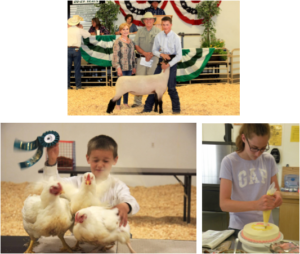
I pledge
My head to clearer thinking,
My heart to greater loyalty,
My hands to larger service, and
My health to better living.
For my club, my community, my country and my world.
No matter what you’re interested in, you will have the chance to build knowledge, skills, leadership abilities and confidence as a Gunnison County 4-H member. 4-H is open to youth ages 5-18 (as of January 1st of the current year). 4-H enrollment is open year round, but members need to designate a project by March 1, so enrolling early in the winter is preferred.
DONATE TODAY! To help support this invaluable community youth program, please contact us. There are many opportunities to help with support including: donating to scholarships, resources, awards, sponsorships, or volunteering your time.
For the Gunnison County 4-H Program, contact the CSU Extension Office at the Fred Field Western Heritage Center (275 South Spruce St.) in Gunnison. Call 641-1260.


